OpenStack Projects For WHMCS
| Line 1: | Line 1: | ||
<meta name="keywords" content="<meta name="keywords" content="openstack projects for whmcs, openstack projects configuration, whmcs openstack projects management, whmcs openstack projects installation, whmcs openstack projects common problems, about whmcs openstack projects, whmcs openstack projects documentation, whmcs openstack projects faq, whmcs openstack projects help, whmcs openstack projects guide, whmcs openstack projects wiki, whmcs openstack projects tutorial, whmcs openstack projects tips, whmcs openstack projects wiki"> | <meta name="keywords" content="<meta name="keywords" content="openstack projects for whmcs, openstack projects configuration, whmcs openstack projects management, whmcs openstack projects installation, whmcs openstack projects common problems, about whmcs openstack projects, whmcs openstack projects documentation, whmcs openstack projects faq, whmcs openstack projects help, whmcs openstack projects guide, whmcs openstack projects wiki, whmcs openstack projects tutorial, whmcs openstack projects tips, whmcs openstack projects wiki"> | ||
<meta name="description" content="ModulesGarden Wiki Contains All The Information You Need About The OpenStack Projects For WHMCS Module."></meta> | <meta name="description" content="ModulesGarden Wiki Contains All The Information You Need About The OpenStack Projects For WHMCS Module."></meta> | ||
| − | + | ||
| − | + | ||
| − | + | ||
| − | + | ||
| − | + | ||
<h4 style="color: #ff0000; font-weight:bold; text-align:center;">Are you going to update your module to version 1.8.X?<br/> | <h4 style="color: #ff0000; font-weight:bold; text-align:center;">Are you going to update your module to version 1.8.X?<br/> | ||
Be sure to review our tips in "[[#Update_Instructions|Update Instructions]]" to prevent any potential issues</h4> | Be sure to review our tips in "[[#Update_Instructions|Update Instructions]]" to prevent any potential issues</h4> | ||
| Line 533: | Line 529: | ||
* '''OpenStack Panel Web Address''' - is the web address for the login page to the OpenStack panel. | * '''OpenStack Panel Web Address''' - is the web address for the login page to the OpenStack panel. | ||
* '''Default Domain Name''' - enter a domain that will be used when the domain name is not provided. Available variables: ''{clientId}, {serviceId}'' and ''{rand}''. | * '''Default Domain Name''' - enter a domain that will be used when the domain name is not provided. Available variables: ''{clientId}, {serviceId}'' and ''{rand}''. | ||
| − | * '''Default Project Name''' - enter a project name | + | * '''Default Project Name''' - enter a project name used when creating a new project. If left empty, the domain name will be used instead. Available variables: ''{clientId}, {serviceId}'' and ''{rand}''. |
| − | * '''Default User Name''' - enter a user name | + | * '''Default User Name''' - enter a user name used when creating a new user. Available variables: ''{clientId}, {serviceId}'' and ''{rand}''. |
* '''Domain Field Content''' - specify the content data that will overwrite the WHMCS Domain Field. | * '''Domain Field Content''' - specify the content data that will overwrite the WHMCS Domain Field. | ||
| − | * '''Client Area Login Information''' - select which | + | * '''Client Area Login Information''' - select which login elements should be visible in the "Server Information" table in the client area. Choose from: ''username, password, domain'' and ''web address.'' |
| − | * '''Log API Requests''' - if you enable, information on API requests will be stored in the 'Module Log' section in your WHMCS. | + | * '''Log API Requests''' - if you enable it, information on API requests will be stored in the 'Module Log' section in your WHMCS. |
| − | * '''Login Restrictions''' - this enables a feature | + | * '''Login Restrictions''' - this enables a feature that enhances security by only issuing temporary passwords that ensure access is granted only for as long as needed. |
* '''Remove Password''' - if enabled, the password will be removed from the database as soon as the project is created. | * '''Remove Password''' - if enabled, the password will be removed from the database as soon as the project is created. | ||
| + | * '''Open Management Panel In New Window''' - decide whether the management panel should open in the same or a new window. | ||
| + | * '''Block Storage Limits Widget''' - block storage resource usage can be displayed in the admin and client area, include at least one resource to enable. | ||
<!-- | <!-- | ||
* '''Overwrite WHMCS Domain''' - if enabled, during the create action, the domain assigned to hosting in WHMCS will be overwritten with the domain name assigned to the project in the OpenStack panel. | * '''Overwrite WHMCS Domain''' - if enabled, during the create action, the domain assigned to hosting in WHMCS will be overwritten with the domain name assigned to the project in the OpenStack panel. | ||
| Line 549: | Line 547: | ||
{| | {| | ||
|style="padding: 0px 0px 15px 15px;"| | |style="padding: 0px 0px 15px 15px;"| | ||
| − | '' '''Compute, Block-Storage, Network, Load Balancer, Container Infrastructure, Traits | + | '' '''Compute, Block-Storage, Network, Load Balancer, Container Infrastructure, Traits''' '' - <br/> these sections may vary depending on the project, some of them might be unavailable for your OpenStack project. You may easily adjust your product to your needs by modifying the available options. Type '' '-1' '' for unlimited.<br/> |
'''''Note:''' Keep in mind that in the case of Virtuozzo server 'Traits' stand for 'Placement Groups' endpoints.'' | '''''Note:''' Keep in mind that in the case of Virtuozzo server 'Traits' stand for 'Placement Groups' endpoints.'' | ||
|} | |} | ||
| Line 557: | Line 555: | ||
{| | {| | ||
|style="padding: 0px 0px 20px 15px;"| | |style="padding: 0px 0px 20px 15px;"| | ||
| − | '' '''Module Custom Web Hooks''' '' - here you may add the URL with WHMCS parameters to perform additional actions after the ''create/suspend/unsuspend/terminate/change package'' actions. | + | '' '''Module Custom Web Hooks''' '' - here you may add the URL with WHMCS parameters to perform additional actions after the ''create/suspend/unsuspend/terminate/change package'' actions.<br/> These hooks allow you to trigger actions on external servers or services via HTTP requests when certain events occur in WHMCS. |
|} | |} | ||
{| | {| | ||
| Line 564: | Line 562: | ||
{| | {| | ||
|style="padding: 0px 0px 20px 15px;"| | |style="padding: 0px 0px 20px 15px;"| | ||
| − | '' '''Module Custom Shell Hooks''' '' - enter the commands with WHMCS parameters to perform additional actions after the ''create/suspend/unsuspend/terminate/change package'' actions.<br/> | + | '' '''Module Custom Shell Hooks''' '' - enter the commands with WHMCS parameters to perform additional actions after the ''create/suspend/unsuspend/terminate/change package'' actions.<br/>These hooks allow you to execute shell commands on your server when specific WHMCS package actions are triggered.<br/> |
Please refer to the following section to correctly set up the [[#OpenID_Configuration_.28VHI.29|openID configuration]] to connect to VHI correctly. | Please refer to the following section to correctly set up the [[#OpenID_Configuration_.28VHI.29|openID configuration]] to connect to VHI correctly. | ||
| Line 573: | Line 571: | ||
{| | {| | ||
|style="padding: 0px 0px 15px 15px;"|'''16. Optionally, you may configure the "Usage Billing Settings" that will be utilized for the Advanced Billing For WHMCS integration.'''<br/> | |style="padding: 0px 0px 15px 15px;"|'''16. Optionally, you may configure the "Usage Billing Settings" that will be utilized for the Advanced Billing For WHMCS integration.'''<br/> | ||
| − | Select specific networks and IP address versions for custom parameter calculations. | + | Select specific networks and IP address versions for custom parameter calculations.<br/> |
| + | '''''Important:''' Advanced Billing For WHMCS version 4.x is required, previous versions are not supported.'' | ||
|} | |} | ||
{| | {| | ||
| Line 645: | Line 644: | ||
===Queue=== | ===Queue=== | ||
{| | {| | ||
| − | |style="padding: 10px 0px 15px 15px;"|Cron job tasks sent to the server through the module can be viewed and managed here. <br/> The basic information includes: | + | |style="padding: 10px 0px 15px 15px;"|At the top of this section you will find information regarding the cron job.<br/> |
| + | The task cards can be used to filter the task table underneath. | ||
| + | |} | ||
| + | {| | ||
| + | |style="padding: 0px 0px 20px 25px;"|[[File:OSP_18_2_1.png]] | ||
| + | |} | ||
| + | {| | ||
| + | |style="padding: 0px 0px 15px 15px;"|Cron job tasks sent to the server through the module can be viewed and managed here. <br/> The basic information includes: | ||
*'''ID''' - identification number unique to each task. | *'''ID''' - identification number unique to each task. | ||
*'''Related Item''' - the product related to the task. Clicking on it will take you to its product page. | *'''Related Item''' - the product related to the task. Clicking on it will take you to its product page. | ||
| Line 673: | Line 679: | ||
|style="padding: 0px 0px 20px 15px;"| Moreover, you can change additional settings by clicking on the three dots above the basic actions. | |style="padding: 0px 0px 20px 15px;"| Moreover, you can change additional settings by clicking on the three dots above the basic actions. | ||
*'''Auto Prune''' - toggle the switch on to enable the task auto prune feature, which will delete the tasks after the specified time has passed. | *'''Auto Prune''' - toggle the switch on to enable the task auto prune feature, which will delete the tasks after the specified time has passed. | ||
| − | *''' Auto Prune Older Than''' - specify the number of days that have to pass before a task is automatically pruned. | + | *'''Auto Prune Older Than''' - specify the number of days that have to pass before a task is automatically pruned. |
| + | *'''Display 'Cron Job Configuration' Hint''' - disable to hide the cron job information. | ||
|} | |} | ||
{| | {| | ||
| Line 707: | Line 714: | ||
** Change Package – upgrading resources of the project. | ** Change Package – upgrading resources of the project. | ||
** Change Password – changing the password of the main user in the project. <br /> ''Note: To change the password input the new password in the 'Password' field, scroll down to the bottom of the page to 'Save Changes' and when the page reloads, click on 'Change Password'.'' | ** Change Password – changing the password of the main user in the project. <br /> ''Note: To change the password input the new password in the 'Password' field, scroll down to the bottom of the page to 'Save Changes' and when the page reloads, click on 'Change Password'.'' | ||
| − | * Scheduled Tasks - data on all scheduled tasks, their status, attempts, and dates | + | * Scheduled Tasks - data on all scheduled tasks, their status, attempts, and dates. |
| + | * Block Storage Limits - if the option is enabled in the module settings, block storage resources usage will be displayed here. | ||
* Metric Statistics - the section is completed with all metrics the module can observe. | * Metric Statistics - the section is completed with all metrics the module can observe. | ||
|} | |} | ||
| Line 862: | Line 870: | ||
|style="padding: 0px 0px 10px 15px;"|2. Metrics can be calculated basing on '''total''' or '''average usage''' for a given period of time. You can edit this in the following file: | |style="padding: 0px 0px 10px 15px;"|2. Metrics can be calculated basing on '''total''' or '''average usage''' for a given period of time. You can edit this in the following file: | ||
<pre>/yourWHMCS/modules/servers/OpenstackProjects/app/Config/configuration.yml</pre> | <pre>/yourWHMCS/modules/servers/OpenstackProjects/app/Config/configuration.yml</pre> | ||
| − | Find the | + | Find the <code>averageBilling</code> option and set: |
*'false' for total usage | *'false' for total usage | ||
*'true' for average usage | *'true' for average usage | ||
|} | |} | ||
{| | {| | ||
| − | |style="padding: 0px 0px | + | |style="padding: 0px 0px 20px 25px;"|[[File:OSP_22.png]] |
| + | |} | ||
| + | {| | ||
| + | |style="padding: 0px 0px 10px 15px;"|3. In the same file, you can disable usage metrics. If you have a large database, this might speed up the module significantly.<br/> | ||
| + | Set <code>disableUsageMetrics</code> to <code>true</code> to disable the function. | ||
| + | |} | ||
| + | {| | ||
| + | |style="padding: 0px 0px 30px 25px;"|[[File:OSP_23.png]] | ||
|} | |} | ||
Revision as of 16:01, 27 November 2024
Are you going to update your module to version 1.8.X?
Be sure to review our tips in "Update Instructions" to prevent any potential issues
Contents |
About OpenStack Projects For WHMCS
| OpenStack Projects For WHMCS is a module that will allow you to provision virtual projects to your customers in a fully automatic manner. The module has been designed in such a way that your customers can place orders and overview them in the client area. As an administrator, you are equipped with all key features to keep track of your customers’ projects. |
- Admin Area Features:
| ✔ Create/Suspend/Unsuspend/Terminate OpenStack Projects |
| ✔ Change Package/Password |
| ✔ Log In To Panel: |
| ✔ With Single Sign-On Support To Virtuozzo Hybrid Infrastructure |
| ✔ View Created Project/User/Domain IDs |
| ✔ View Scheduled Tasks |
| ✔ Set Up Project Configuration: |
| ✔ Define Default Domain |
| ✔ Define Client Projects Mode: |
| ✔ Default |
| ✔ Only One Domain Per Client |
| ✔ With Domain Permissions |
| ✔ Without Domain Permissions |
| ✔ Only One Domain And User Per Client |
| ✔ Define User Roles |
| ✔ Hide User Password In Client Area |
| ✔ Inherit Domain Roles |
| ✔ Provide OpenStack Panel Web Address |
| ✔ Provide Default Domain/Project/User Name |
| ✔ Select WHMCS Domain Field Content: |
| ✔ Project Name |
| ✔ Domain Name |
| ✔ Disabled |
| ✔ Select Client Area Login Information |
| ✔ Toggle Logging API Requests |
| ✔ Enable Login Restrictions |
| ✔ Toggle Password Removal After Project Creation |
| ✔ Toggle Opening Management Panel In New Window |
| ✔ Set Up Limits For: |
| ✔ Compute |
| ✔ Block Storage |
| ✔ Network |
| ✔ Load Balancer |
| ✔ Container Infrastructure |
| ✔ Kubernetes |
| ✔ Traits (OpenStack) / Placement Groups (Virtuozzo) |
| ✔ QoS Policy - Minimum Bandwidth Rate Rules |
| ✔ QoS Policy - Maximum Bandwidth Limit Rules |
| ✔ Set Up Module Custom Web And Shell Hooks |
| ✔ Set Up Usage Billing Settings |
| ✔ Set Up Configurable Options Settings |
| ✔ Generate Configurable Options |
| ✔ Set Up OpenID Connect For Single Sign-On To Virtuozzo Hybrid Infrastructure |
| ✔ Run Server Connection Test |
- Client Area Features:
| ✔ View Project Details: |
| ✔ Web Address |
| ✔ Domain |
| ✔ Username |
| ✔ Password |
| ✔ View Project Servers |
| ✔ Manage Login Restrictions: |
| ✔ Enable Temporary Passwords Valid Only For Predefined Time |
| ✔ Secure User Accounts To Prevent Access |
| ✔ Log In To Panel |
| ✔ With Single Sign-On Support To Virtuozzo Hybrid Infrastructure |
- Configurable Options:
| ✔ Backup Gigabytes |
| ✔ Backups |
| ✔ Cores |
| ✔ Fixed IP Addresses |
| ✔ Floating IP Address |
| ✔ Floating IP Addresses |
| ✔ Gigabytes |
| ✔ Groups |
| ✔ Hard Limit |
| ✔ Health Monitor |
| ✔ Injected File Content [Bytes] |
| ✔ Injected File Path [Bytes] |
| ✔ Injected Files |
| ✔ Instances |
| ✔ Key Pairs |
| ✔ Listener |
| ✔ Load Balancer |
| ✔ Member |
| ✔ Metadata Items |
| ✔ Network |
| ✔ Per Volume Gigabytes |
| ✔ Pool |
| ✔ Port |
| ✔ QoS Minimum Bandwidth Rates Rules |
| ✔ QoS Maximum Bandwidth Limit Rules |
| ✔ RAM [MB] |
| ✔ Role-based Access Control Policy (RBAC Policy) |
| ✔ Router |
| ✔ Security Group |
| ✔ Security Group Rule |
| ✔ Security Group Rules |
| ✔ Security Groups |
| ✔ Server Group Members |
| ✔ Server Groups |
| ✔ Snapshots |
| ✔ Subnet |
| ✔ Subnet Pool |
| ✔ Traits (OpenStack) / Placement Groups (Virtuozzo) |
| ✔ Volumes |
- Required Components:
| ✔ Gnocchi (Required For Billing) |
- General Info:
| ✔ Integrated With Advanced Billing For WHMCS - Actual Project Resource Usage Billing |
| ✔ Integrated With Products Reseller For WHMCS - End-To-End Solution For Products And Servers Reselling |
| ✔ Multi-Language Support |
| ✔ Supports Latest Stable OpenStack and Previous |
| ✔ Supports OpenStack Gnocchi |
| ✔ Supports Virtuozzo Hybrid Infrastructure |
| ✔ Supports PHP 8.2 Back To PHP 7.4 |
| ✔ Supports WHMCS Metric Billing - Integration: CPU, Compute Instance Booting Time, Disk Device Read Bytes, Disk Device Read Requests, Disk Device Write Bytes, Disk Device Write Requests, Disk Ephemeral Size, Disk Root Size, Floating IP Addresses, IP Addresses, Load Balancers, Memory, Memory Usage, Network Incoming Bytes, Network Incoming Packets, Network Outgoing Bytes, Network Outgoing Packets, OS Images, VCPUs, Volume Size, Volumes Usage |
| ✔ Supports WHMCS Themes "Six" And "Twenty-One" |
| ✔ Supports WHMCS V8.11 Back To WHMCS V8.8 |
| ✔ Requires ionCube Loader V13 Or Later |
| ✔ Easy Module Upgrade To Open Source Version |
Installation and Configuration
| This tutorial will show you how to successfully install and configure OpenStack Projects For WHMCS smoothly. We will guide you step by step through the whole installation and configuration process. |
Installation
| 1. Log in to our client area and download the module. |
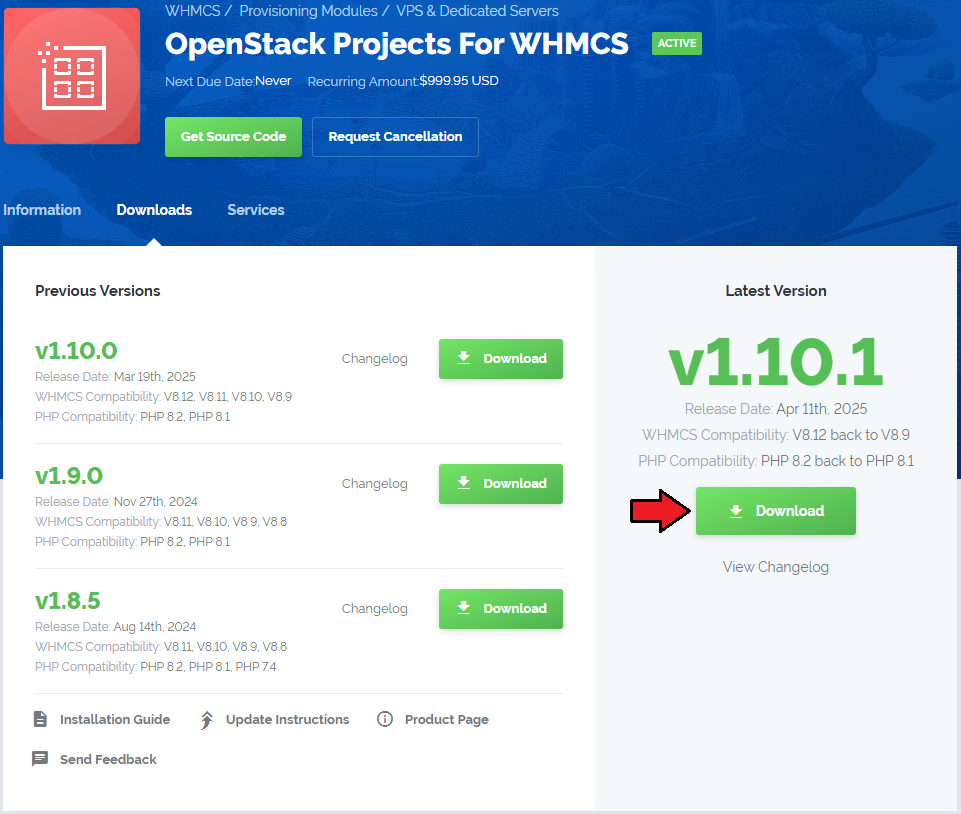
|
| 2. Upload and extract the extension into the main WHMCS directory. Extracted files in your WHMCS directory should look like this: |
| 3. When you install OpenStack Projects For WHMCS for the first time, you have to rename the 'license_RENAME.php' file. The file is located in '/yourWHMCS/modules/servers/OpenStackProjects/license_RENAME.php'. Rename it from 'license_RENAME.php' to 'license.php'. |
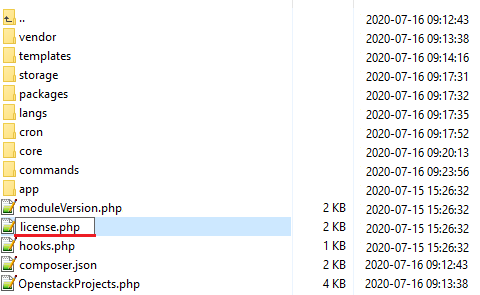
|
| 4. In order to configure your license key, you have to edit the previously renamed 'license.php' file. Enter your license key between the quotation marks as presented on the following screen. |

|
| 5. Now, set up the 'storage' folder as recursively writable. This folder is available at '/yourWHMCS/modules/servers/OpenStackProjects/'. |
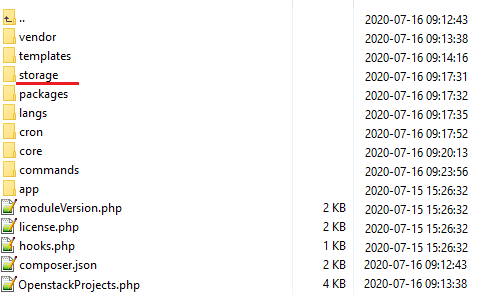
|
| 6. Now you have to activate the module in your WHMCS system. Log in to your WHMCS administrator area. Go to 'System Settings' → 'Addon Modules'. |
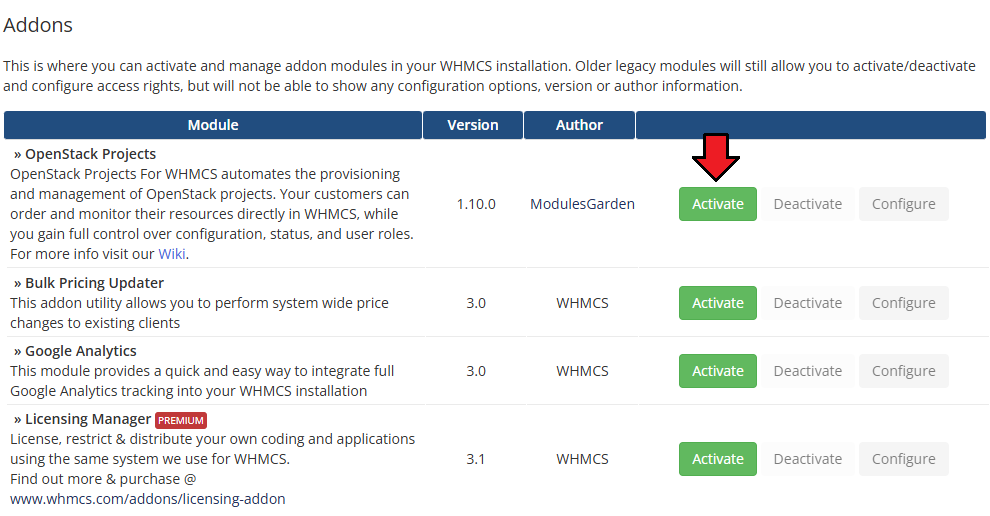
|
| 7. In the next step, you need to permit access to the module. To do so, click on the 'Configure' button, select administrator groups that should have access to this addon and press 'Save Changes'. |
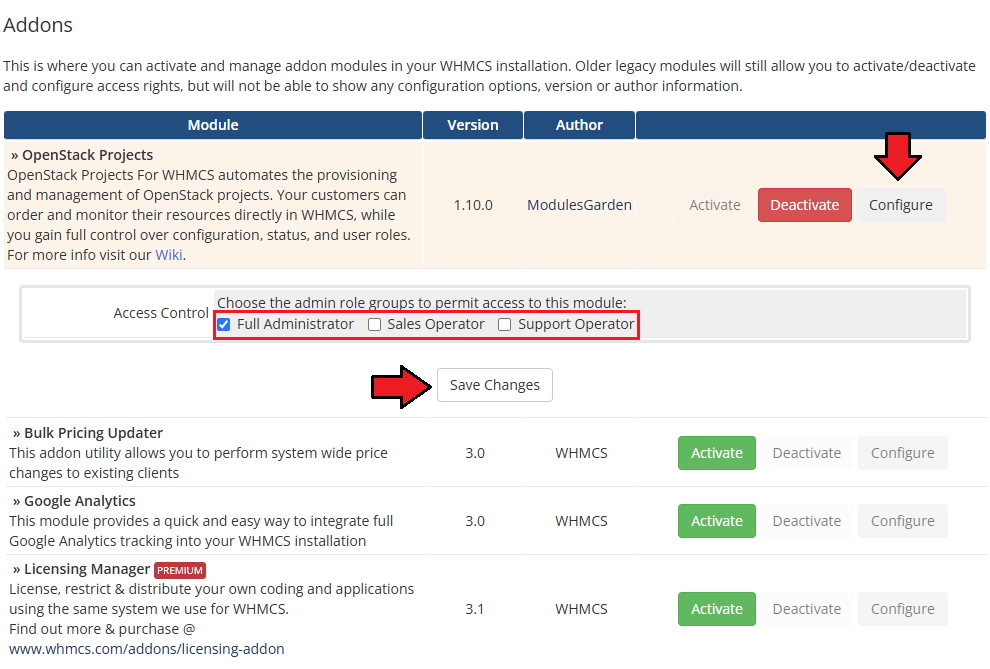
|
8. Finally, set up the cron command line provided below and define its frequency (1 minute interval is suggested).
php -q /yourWHMCS/modules/servers/OpenstackProjects/cron/cron.php queue This enables tasks such as 'suspend resources,' 'unsuspend resources,' 'terminate resources,' and 'lock account' to queue and run. |
| 9. You have just successfully installed OpenStack Projects For WHMCS! You can access your module under 'Addons' → 'OpenStack Projects'. |
Configuration of Server
| Before you can go on, you need to copy your 'API Details' . You will need them to connect with the server successfully. Proceed to your 'OpenStack' panel. All necessary information will be found in the 'View Credentials' section under 'API Access' . |
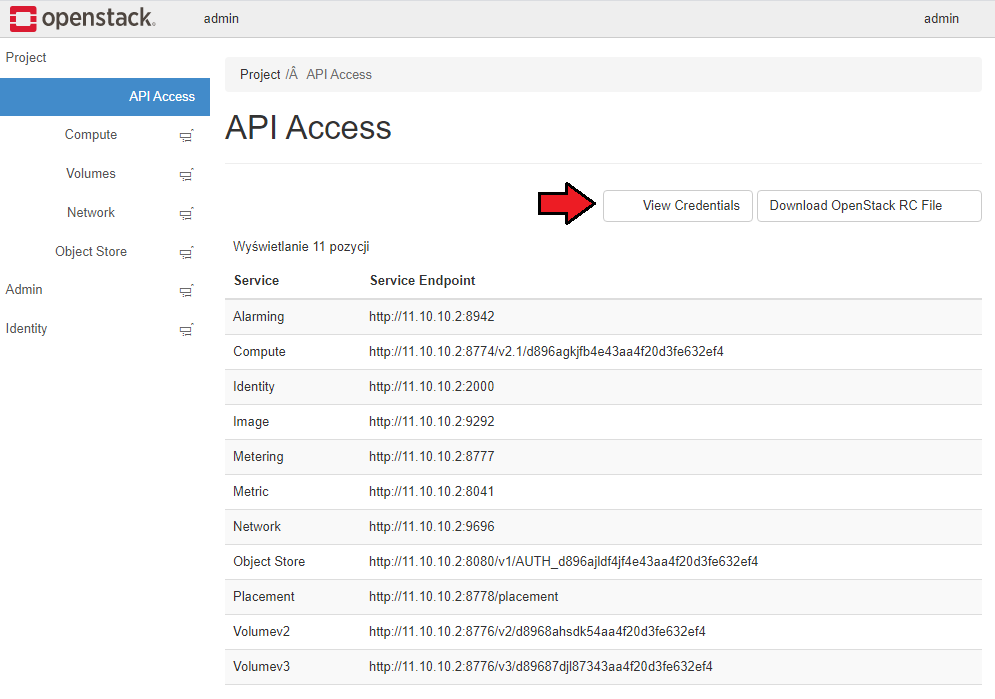
|
| 6. Now, log in to your WHMCS and proceed to 'Setup' → 'Products/Services' → 'Servers' and press 'Add New Server'. |
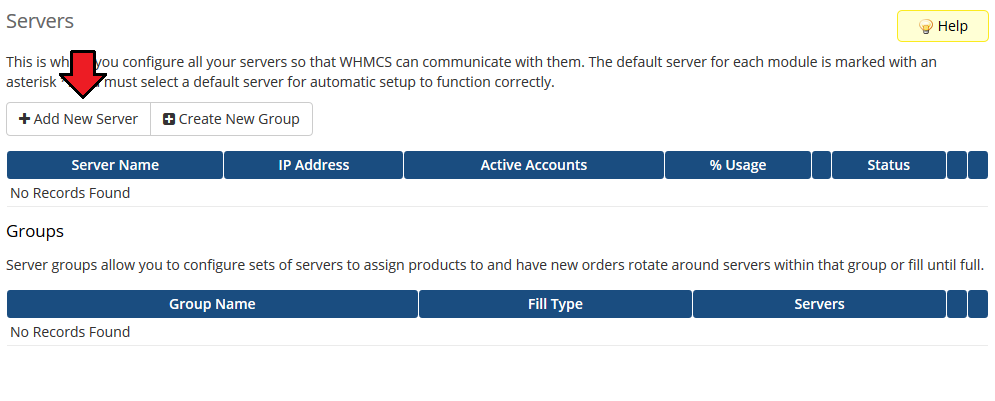
|
| 7. Next, enter your server 'Name' , 'Hostname' , 'IP Address' and select 'Openstack Projects' from the 'Module' field. Now, provide your 'OpenStack Server Details' . To download the 'Identity Version' , you need to click 'Get Versions' next to 'Identity Port/Path' . |
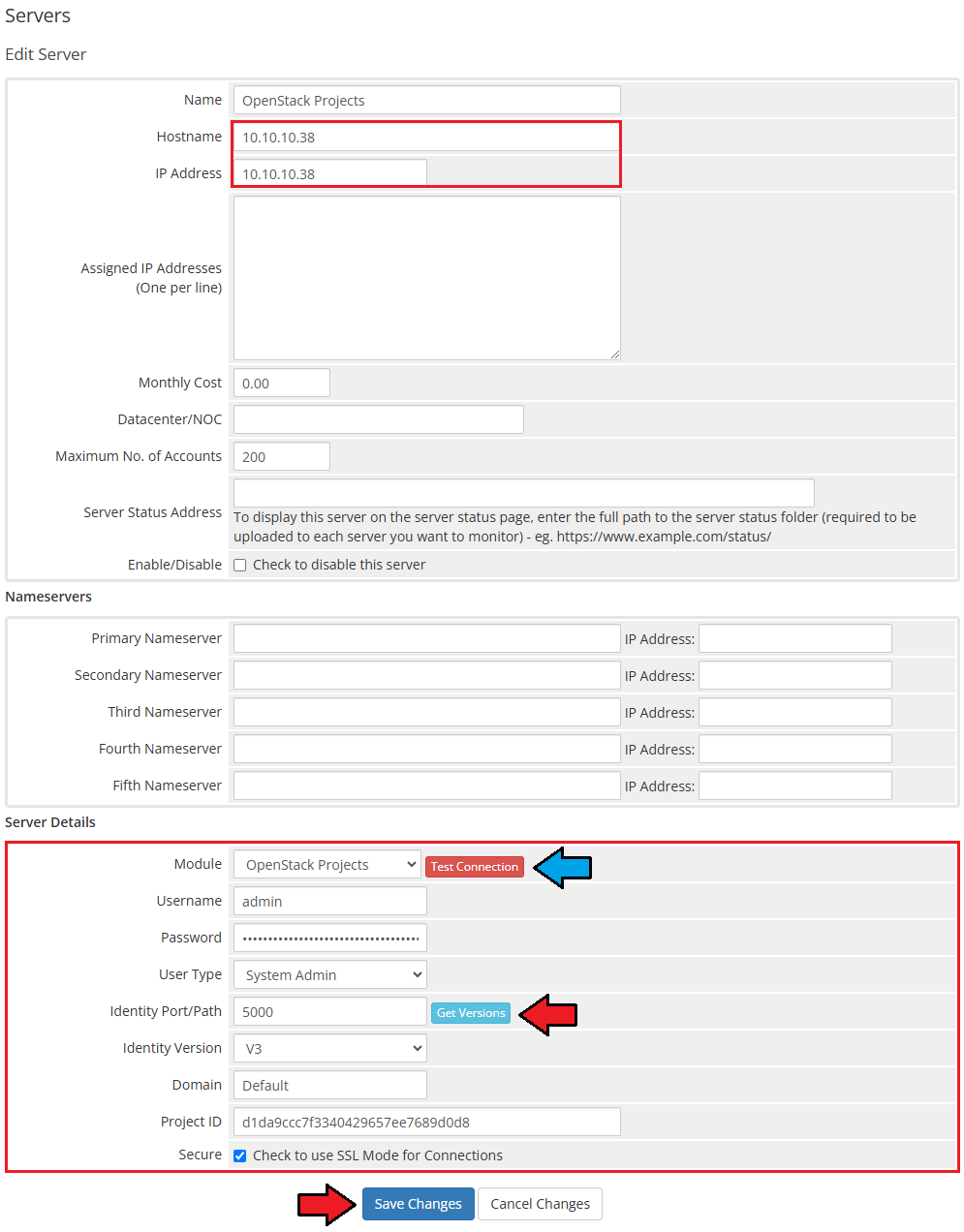
|
| Integration with Virtuozzo Hybrid Infrastructure If you you use Virtuozzo Hybrid Infrastructure (VHI) – OpenStack from Virtuozzo, please use the following guide: 1. WHMCS server must have access to VHI OpenStack API, please open the required ports according to the guide 2. Configure OpenStack endpoint OpenStack endpoint 3. Use system admin or domain admin credentials to access the cluster from WHMCS side:
Use the above data to fill out the server creation form in the WHMCS admin area. |
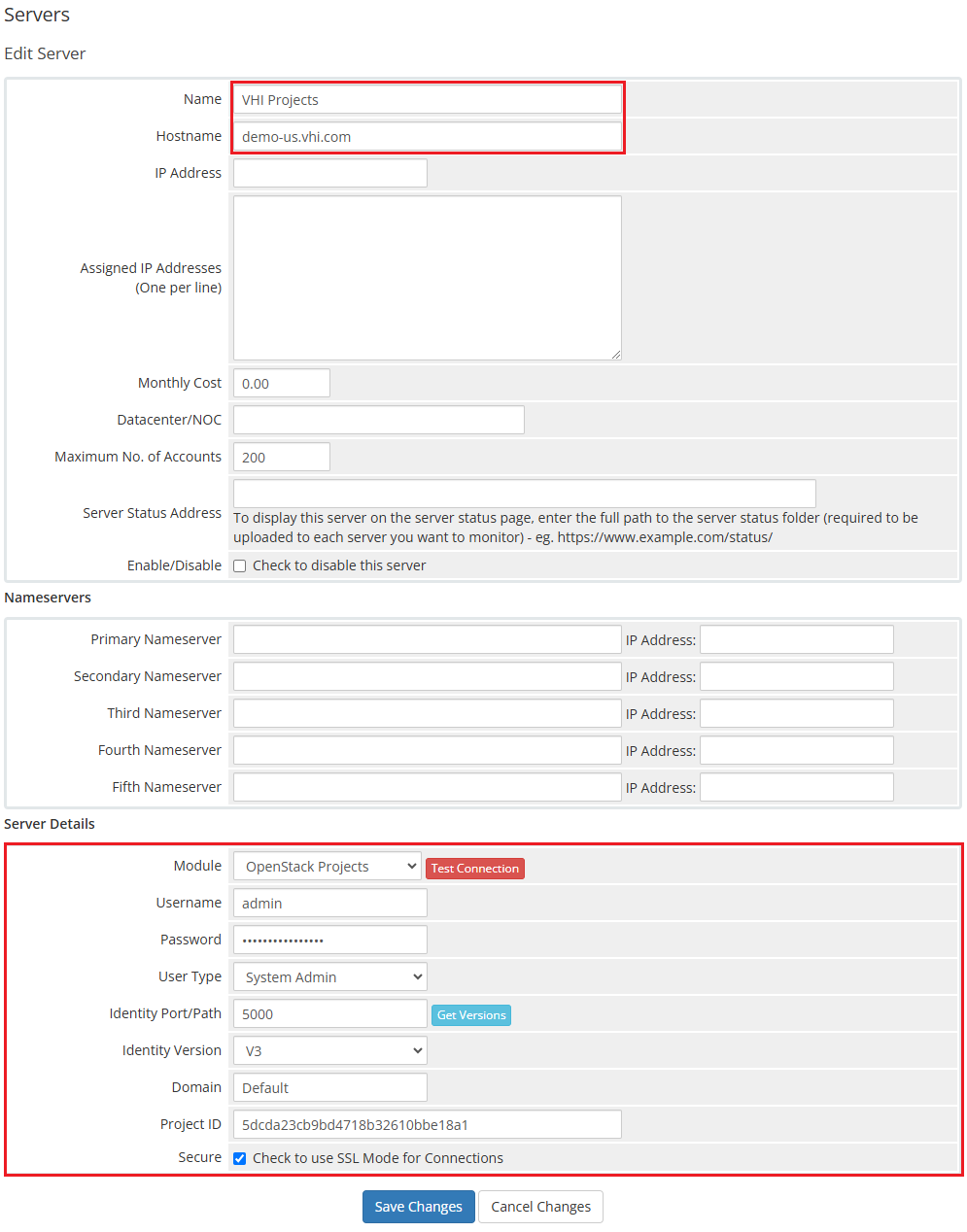
|
| 8. It is time to create a server group. To do so, click on 'Create New Group' . |
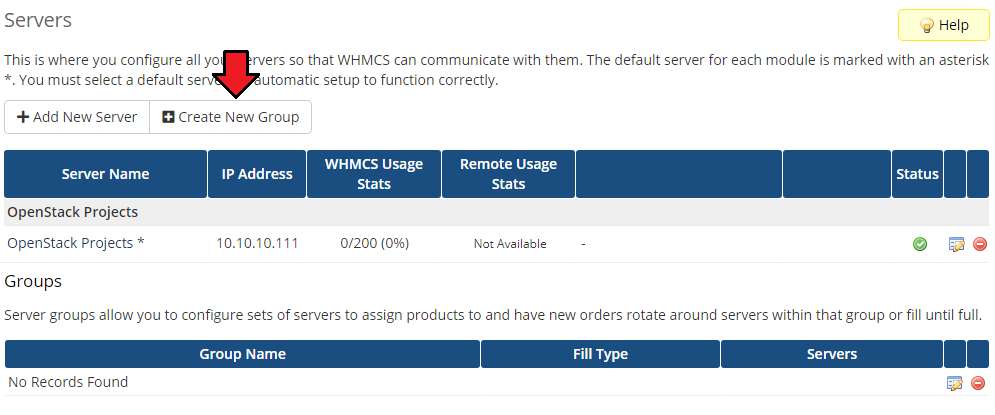
|
| 9. Enter a name, click on your previously created server, press 'Add' and afterward 'Save Changes' . Important: Please do not add more than one server into a single server group, as the module always fetches data from the first server listed in the group. |
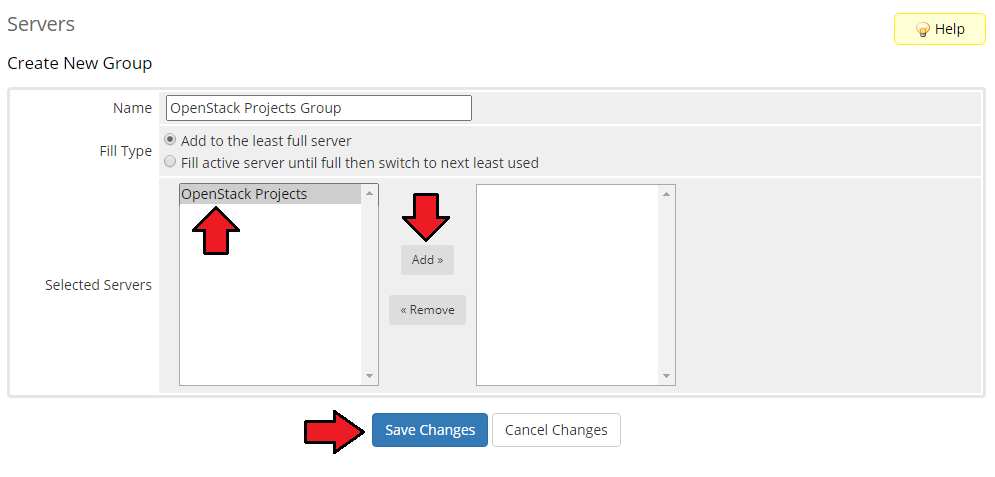
|
Configuration of Product
| 10. In order to create and configure a product, go to 'Setup' → 'Products/Services' → 'Products/Services'. Click on 'Create a New Group'. |

|
| 11. Enter your product group name and press 'Save Changes'. |
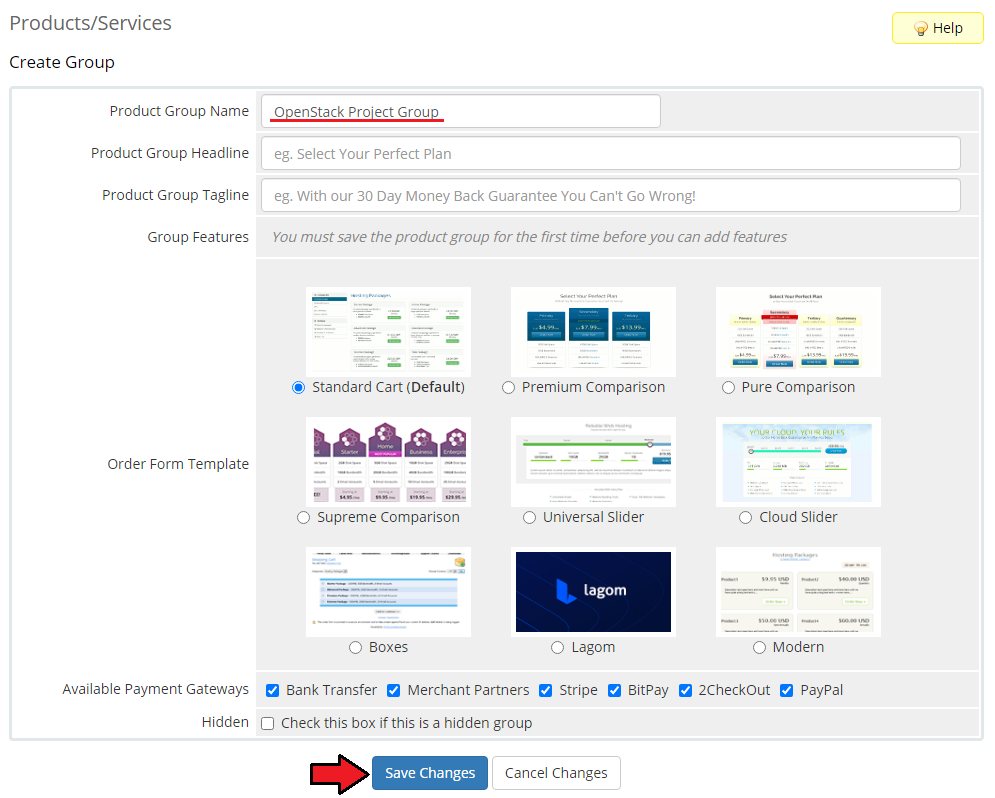
|
| 12. Once you have a product group, you can create a new product. To do so, first click on 'Create a New Product'. |

|
| 13. Afterward, choose your product type, enter your product name, choose module and the product group from the dropdown menus. Press 'Continue'. |
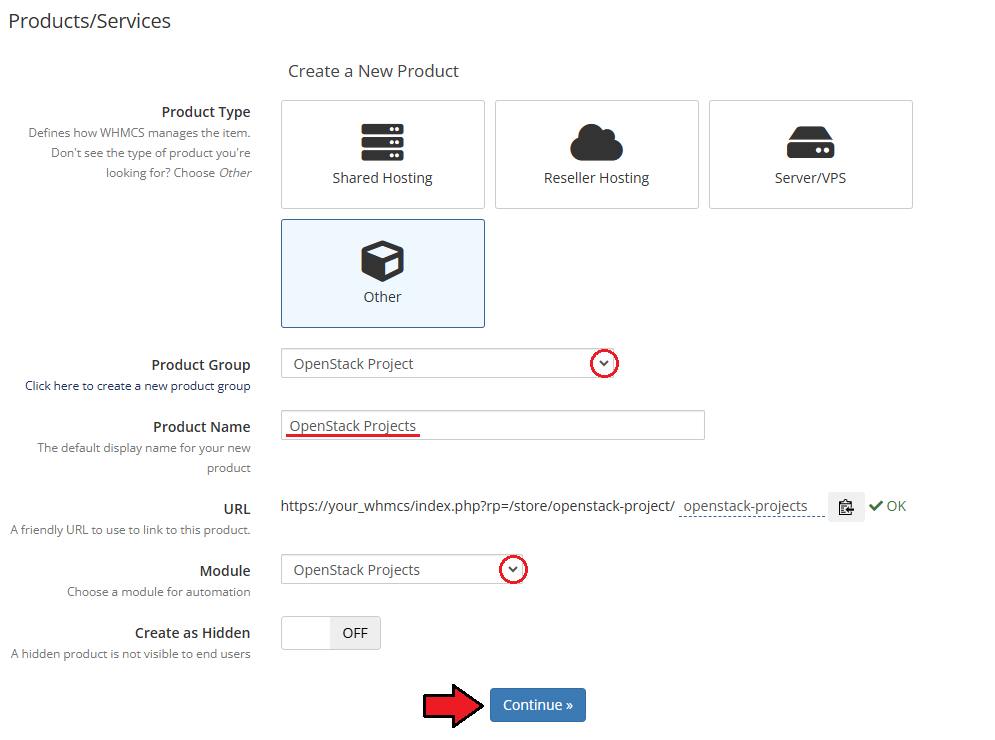
|
| 14. Now, go to the 'Module Settings' section, choose your previously created server group from the dropdown menu. If you did not set the proper permissions, you will be asked to do it now. |
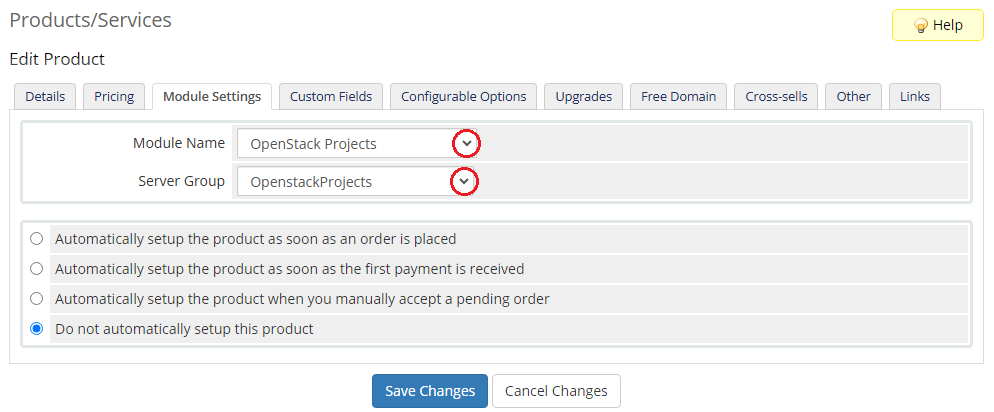
|
| 15. Now, let's start configuring the settings. Note: The below description refers to the "VHI" product configuration. Configuration:
|
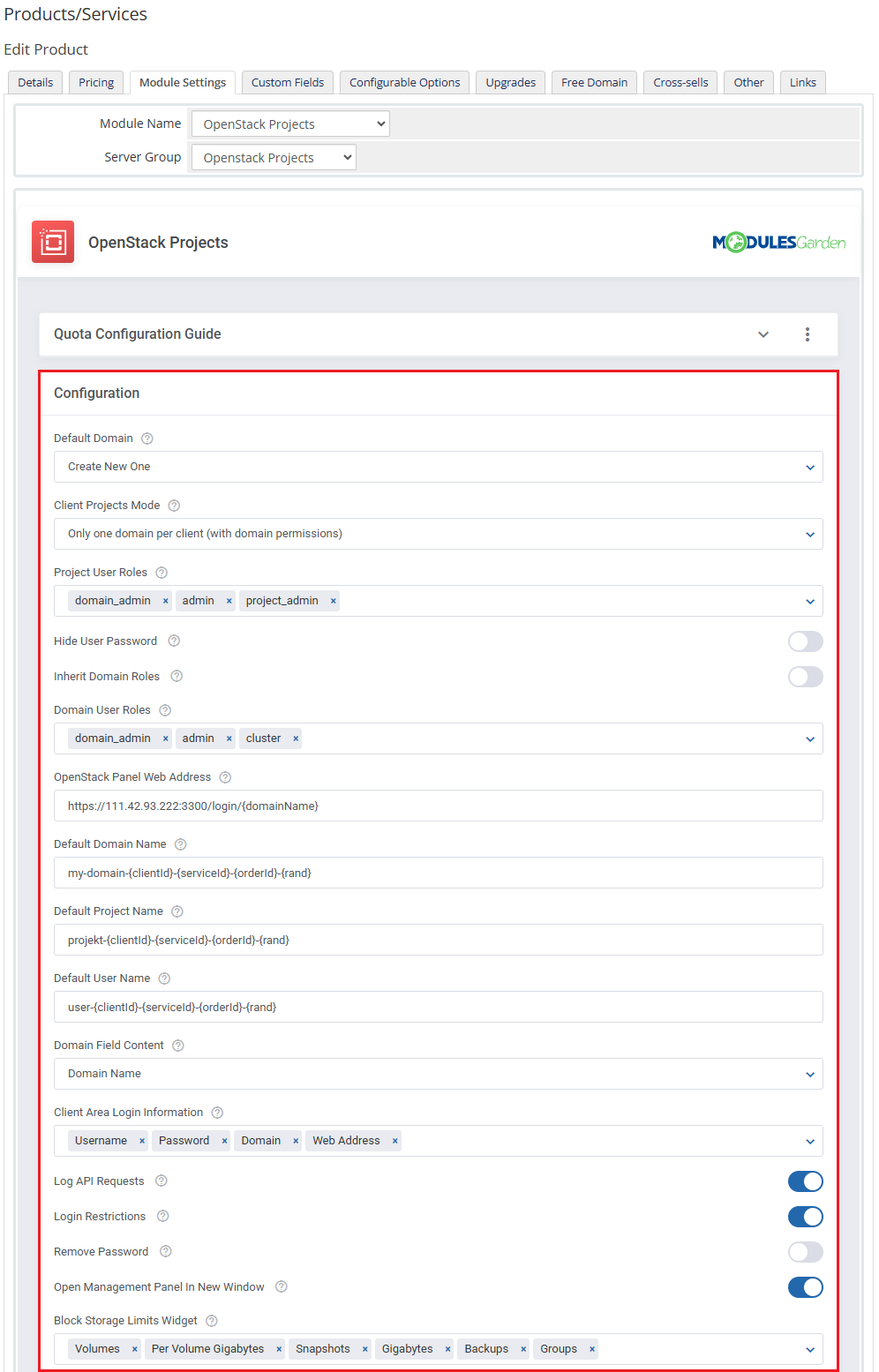
|
|
Compute, Block-Storage, Network, Load Balancer, Container Infrastructure, Traits - |
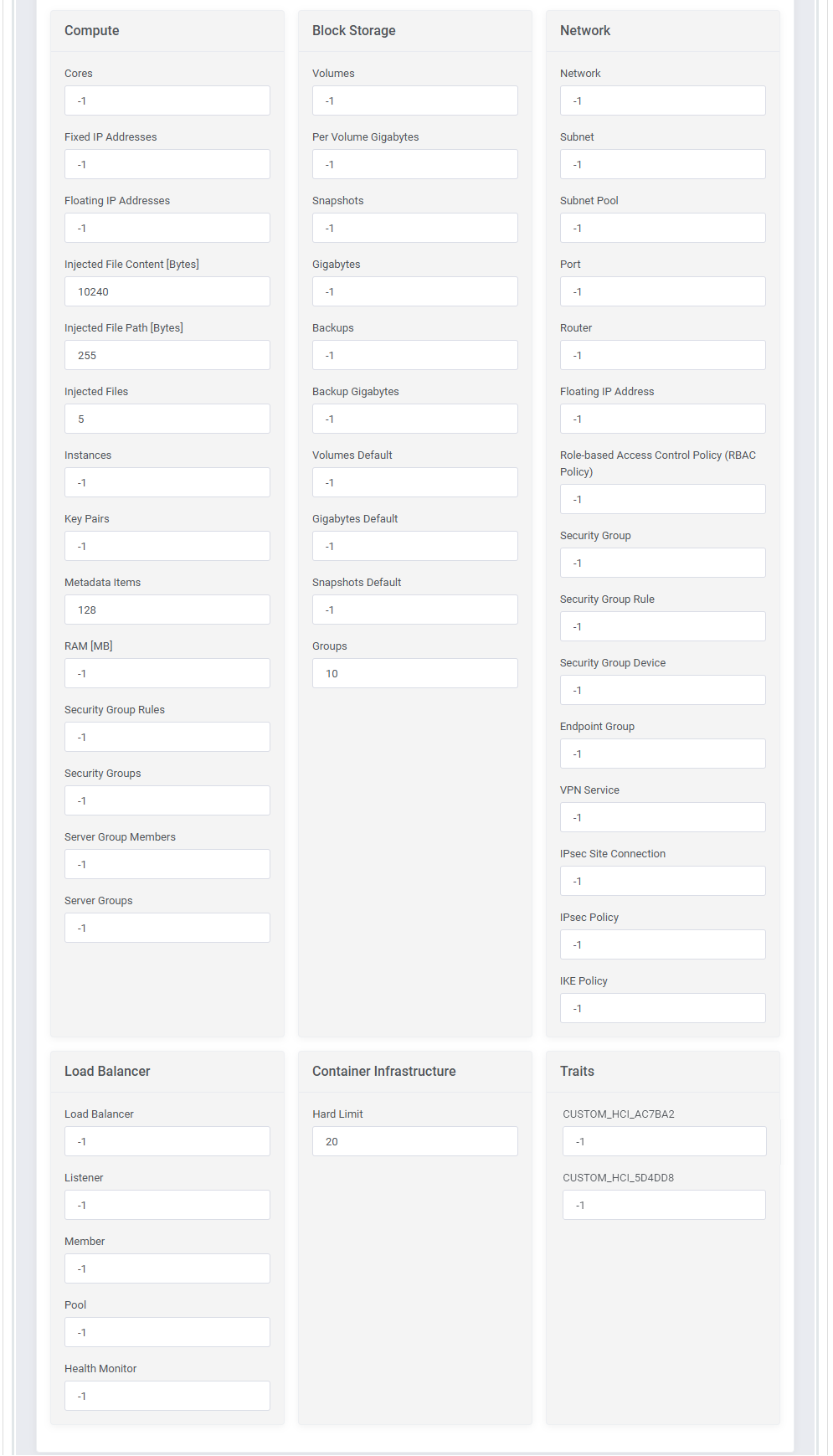
|
|
Module Custom Web Hooks - here you may add the URL with WHMCS parameters to perform additional actions after the create/suspend/unsuspend/terminate/change package actions. |
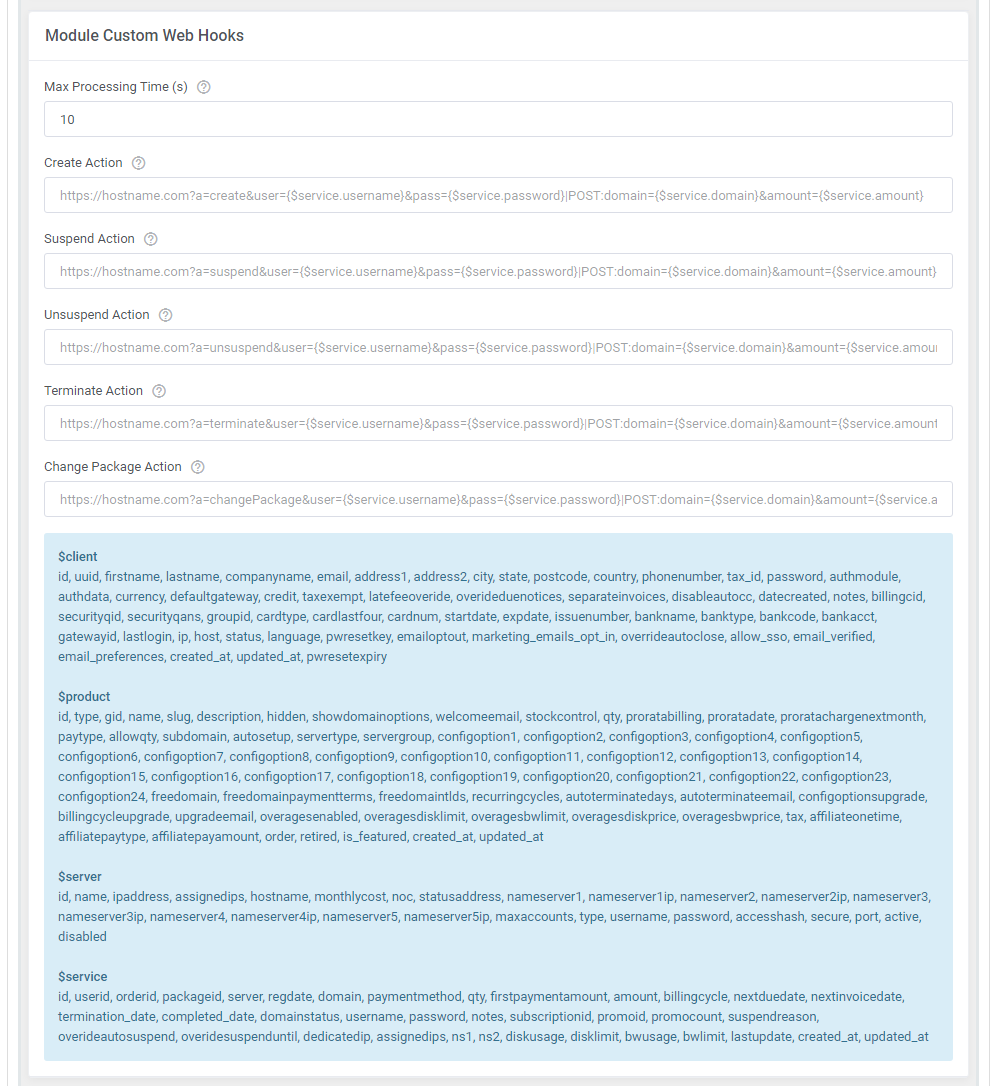
|
|
Module Custom Shell Hooks - enter the commands with WHMCS parameters to perform additional actions after the create/suspend/unsuspend/terminate/change package actions. |
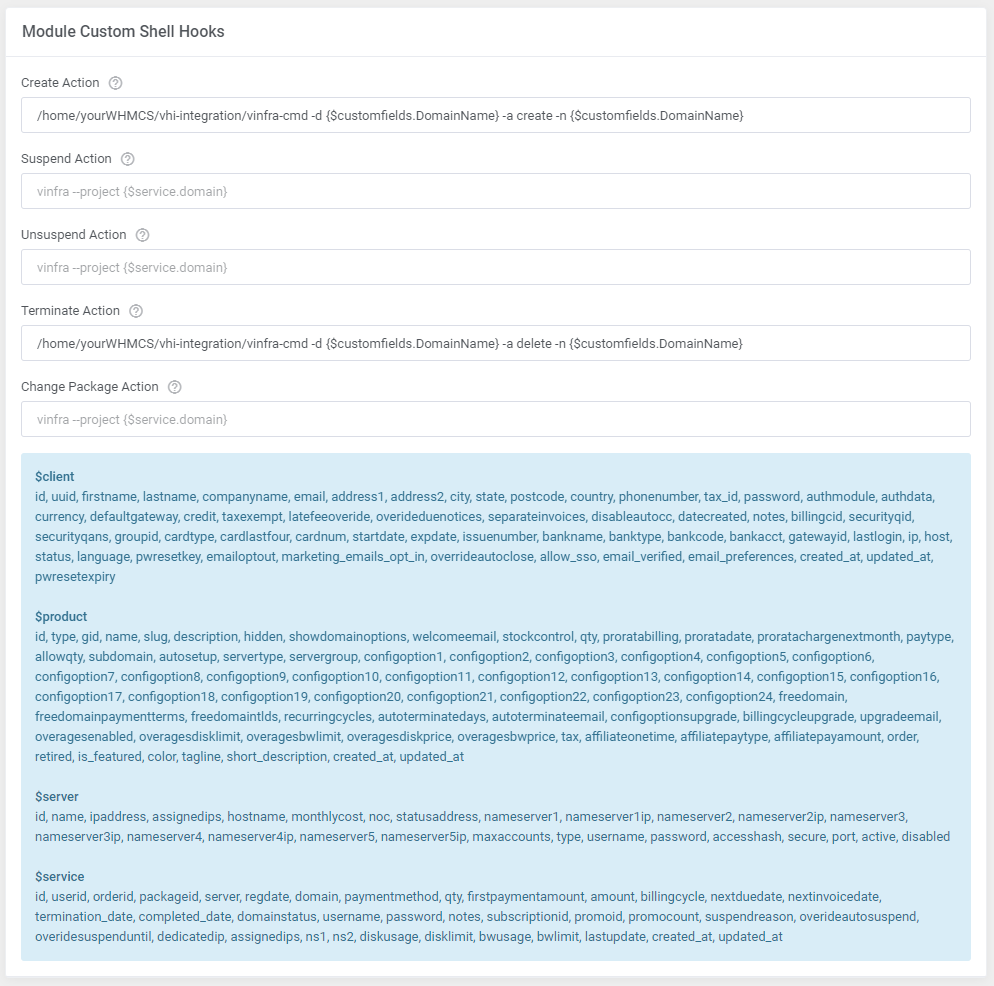
|
| 16. Optionally, you may configure the "Usage Billing Settings" that will be utilized for the Advanced Billing For WHMCS integration. Select specific networks and IP address versions for custom parameter calculations. |

|
| 17. At the end of the configuration process, you can enable 'Metric Billing' and decide whether you want to generate configurable options for the product. Configurable options can be used by your clients to select each virtual machine parameter individually during order placement. There is also an 'Alternative Mode' available, which changes the way the configurable options values are verified and calculated. |

|
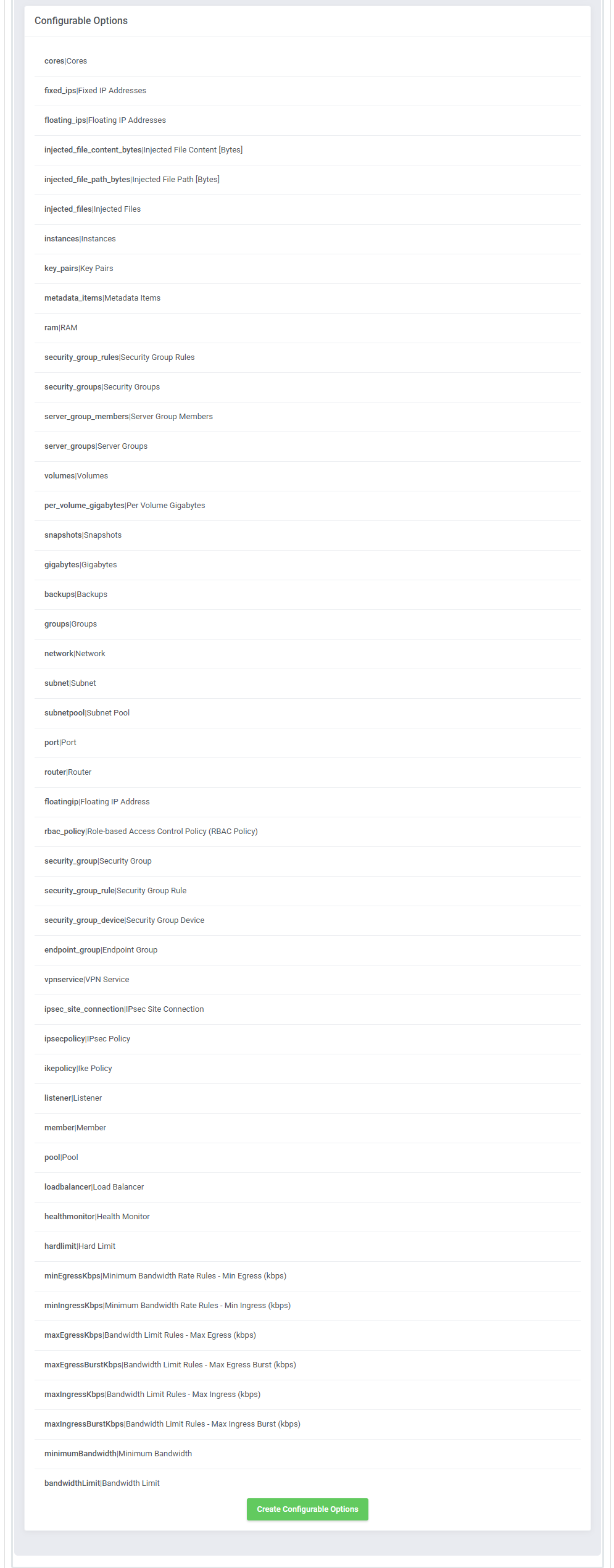
|
| Now, select which options you want to generate and confirm by clicking 'Create' . Note that the configuration for disabled options will still be taken from the configuration of the main product. More information about how to use configurable options can be found here or in the official WHMCS documentation. |
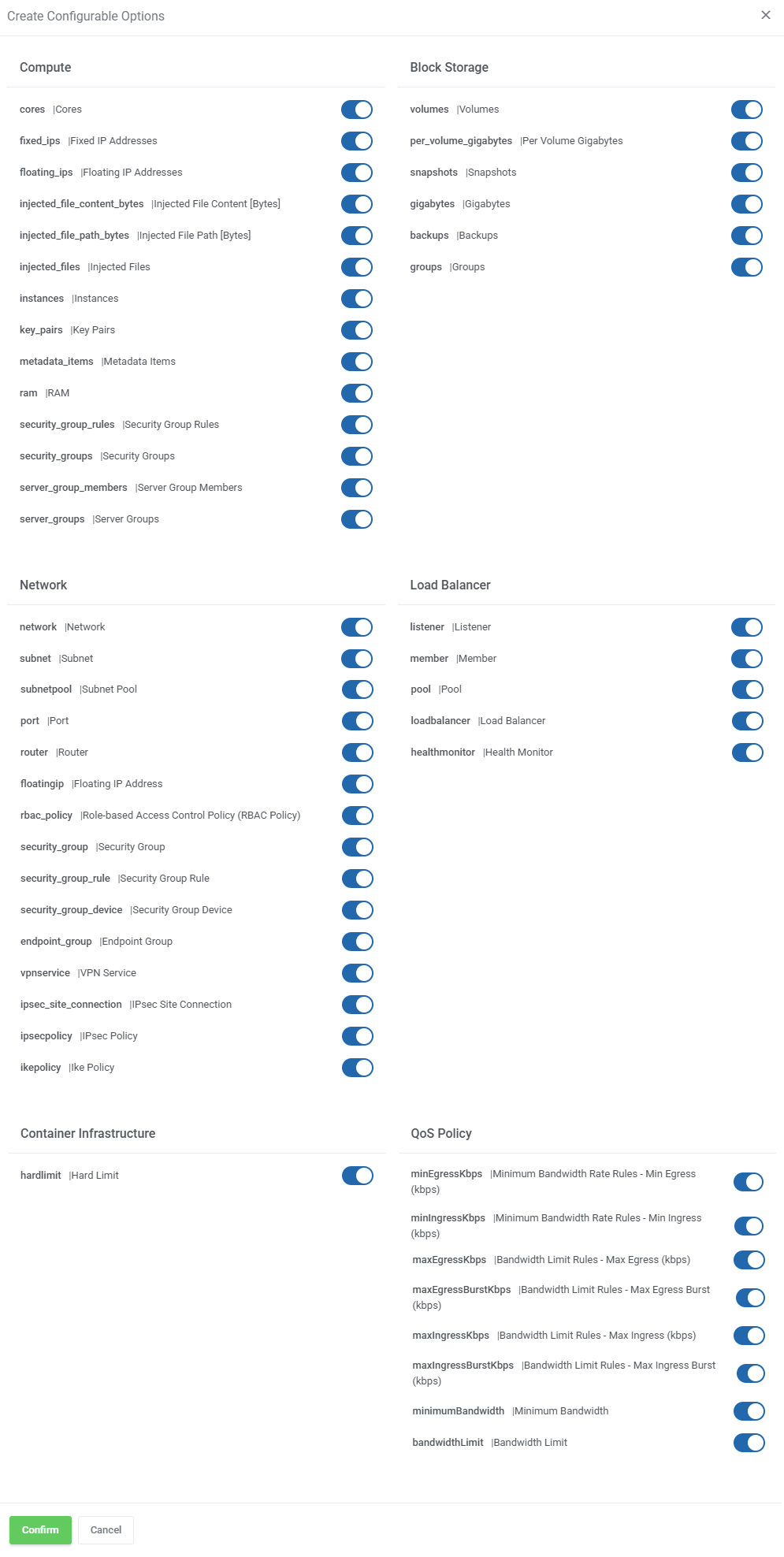
|
User Roles Configuration
Roles, or in other words permissions, in OpenStack can be assigned to users, they can be associated with either a domain or a project.
|
| Move to 'Products/Services' → 'Module Settings' → 'Configuration'. There you will find all the options associated with the roles configuration: |
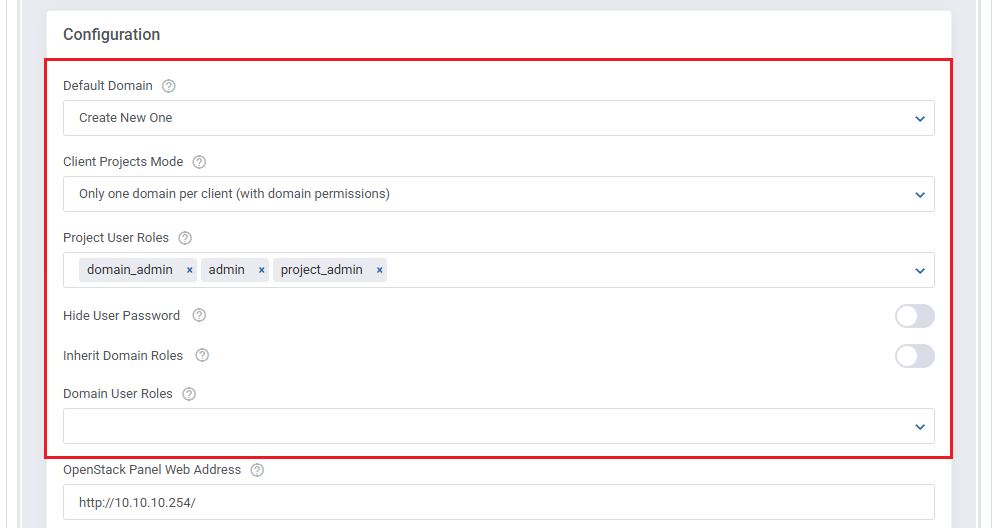
|
|
| Important: When upgrading from 1.3.0 to 1.4.0 module version and you do not save changes in the module settings the roles will work as in the previous version. |
Management
| OpenStack Projects For WHMCS is a module that will allow you to provision virtual projects to your customers in a fully automatic manner. Check the manual below to learn how to configure the module to take all the advantages it has to offer. |
Addon Module
| While management of specific projects mostly takes place in the admin area, functions that affect the whole module can be found in the addon. See the section below for an in depth explanation of each of them. |
Queue
| At the top of this section you will find information regarding the cron job. The task cards can be used to filter the task table underneath. |
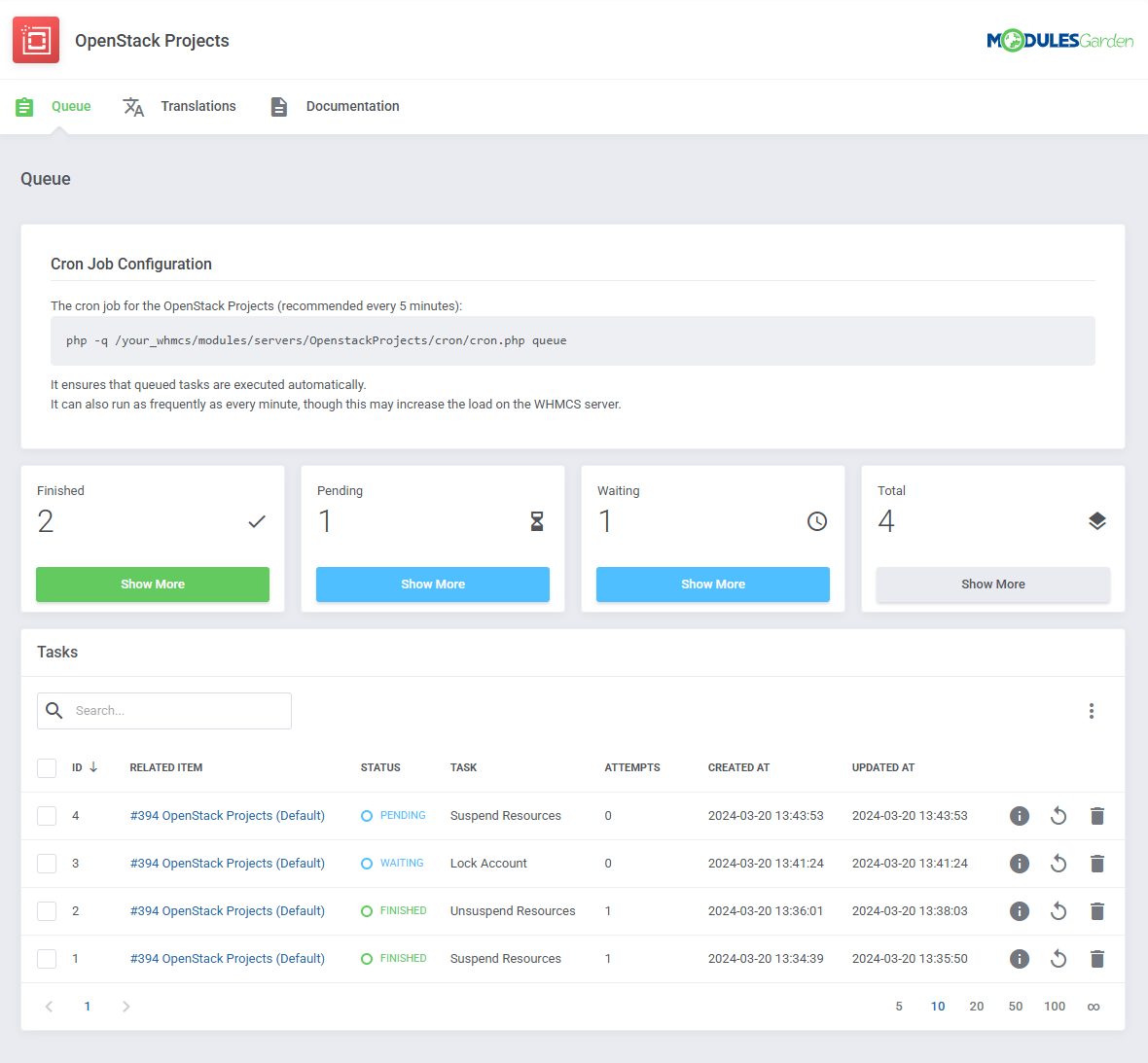
|
| Cron job tasks sent to the server through the module can be viewed and managed here. The basic information includes:
|
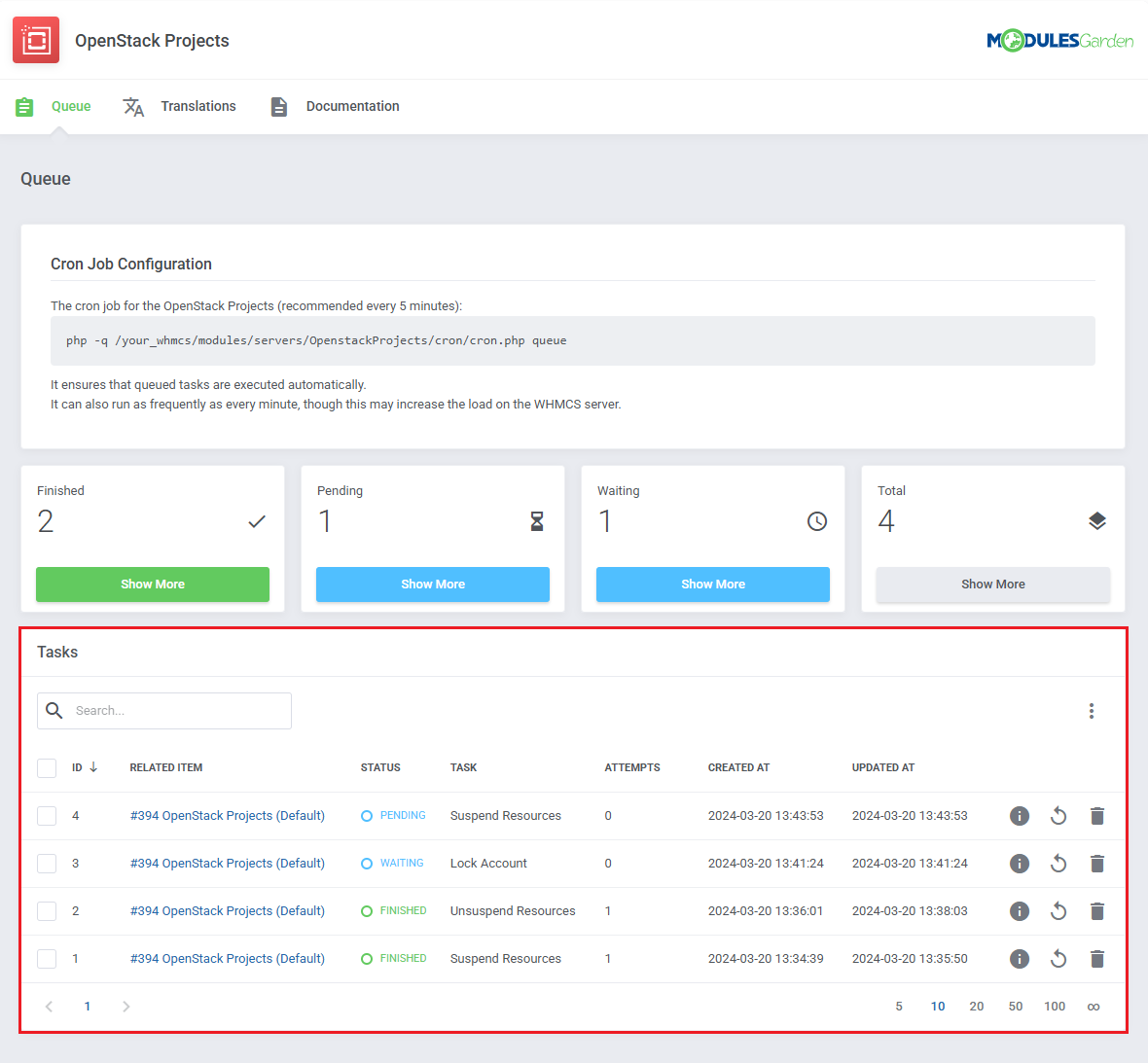
|
On the right side of the tasks list you will find the action buttons. These are in order:
|
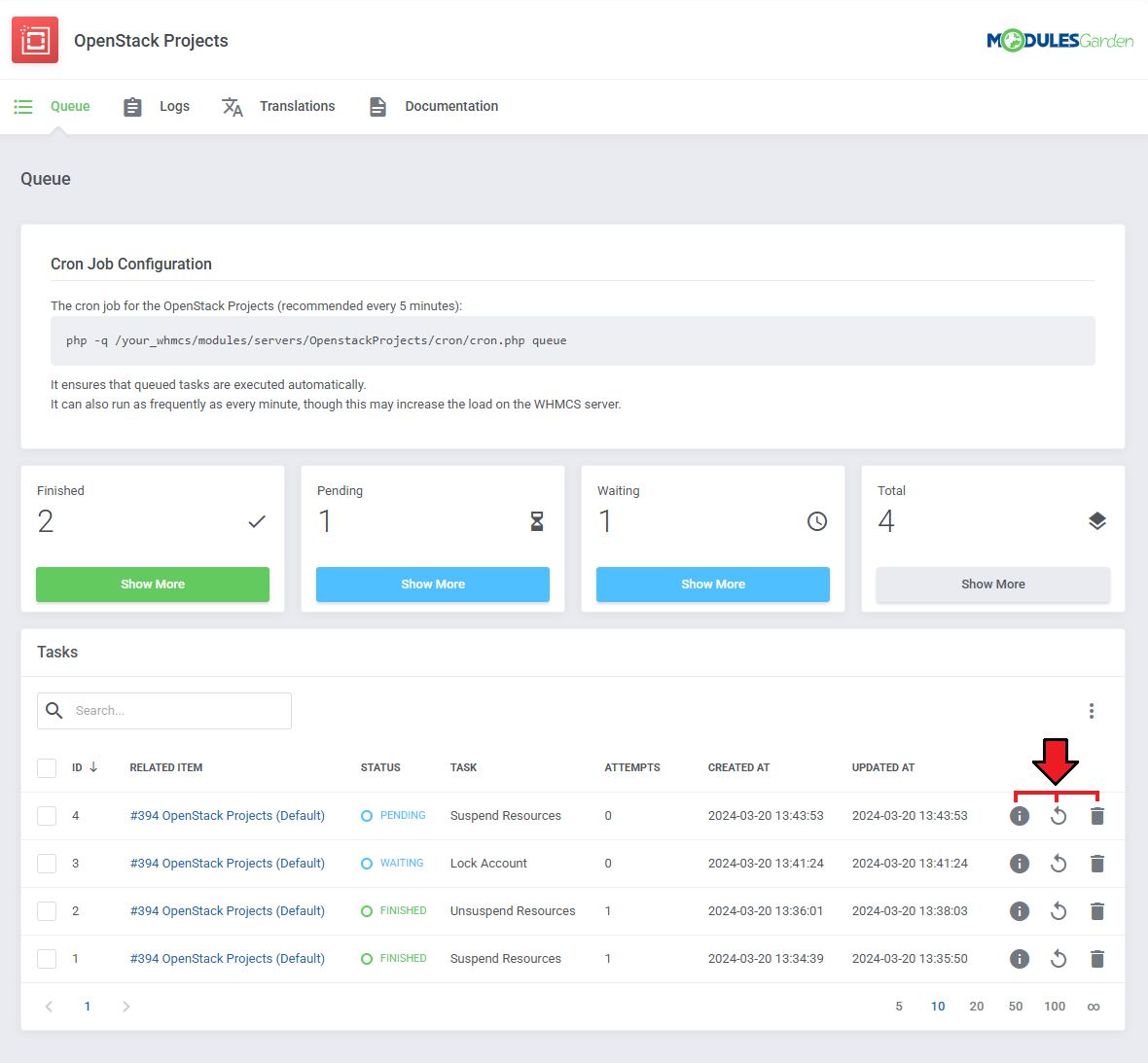
|
Moreover, you can change additional settings by clicking on the three dots above the basic actions.
|
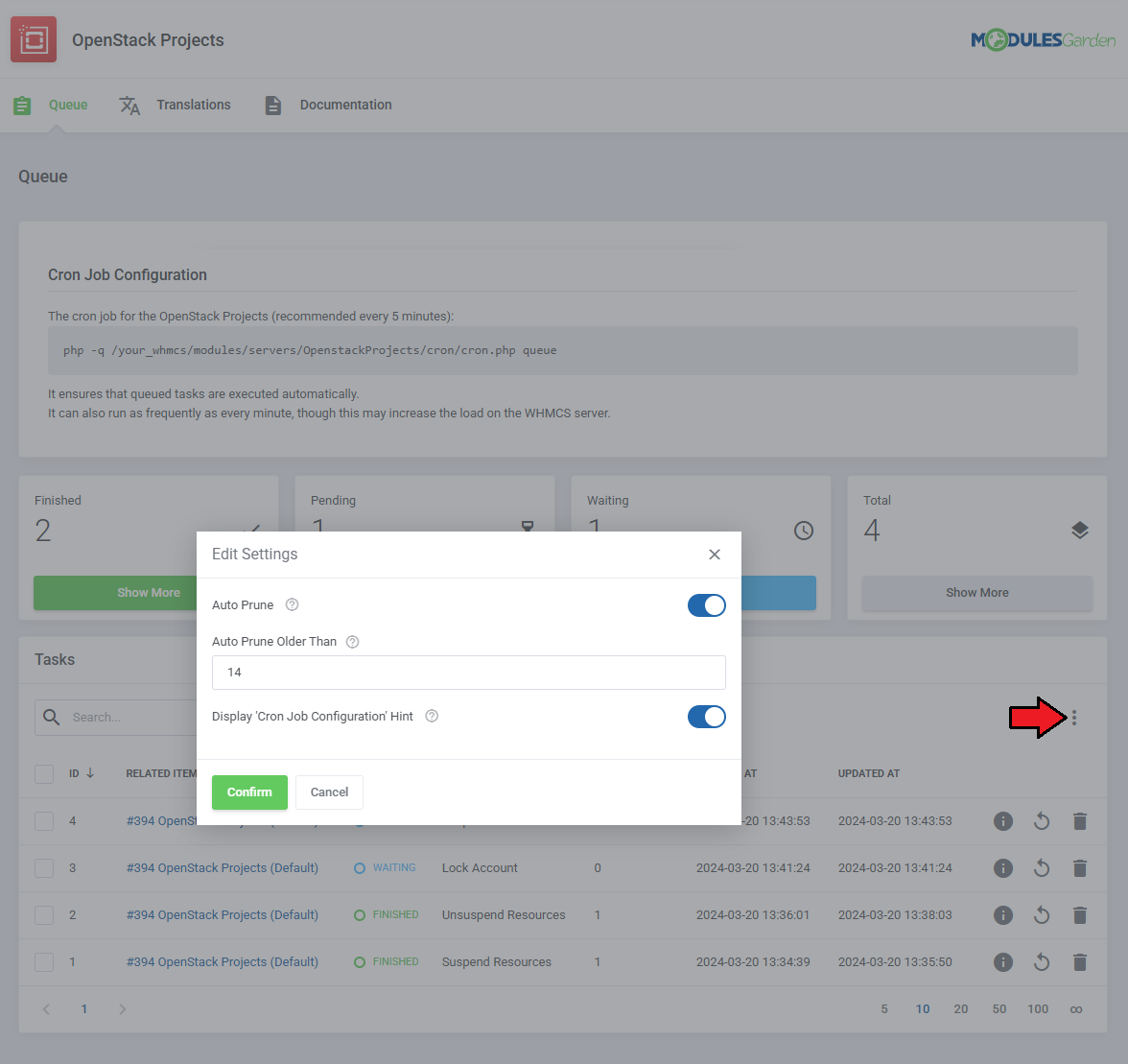
|
| Remember to make use of the search bar when you need to find a specific task, and the mass action feature, when you need to delete multiple tasks at once. |
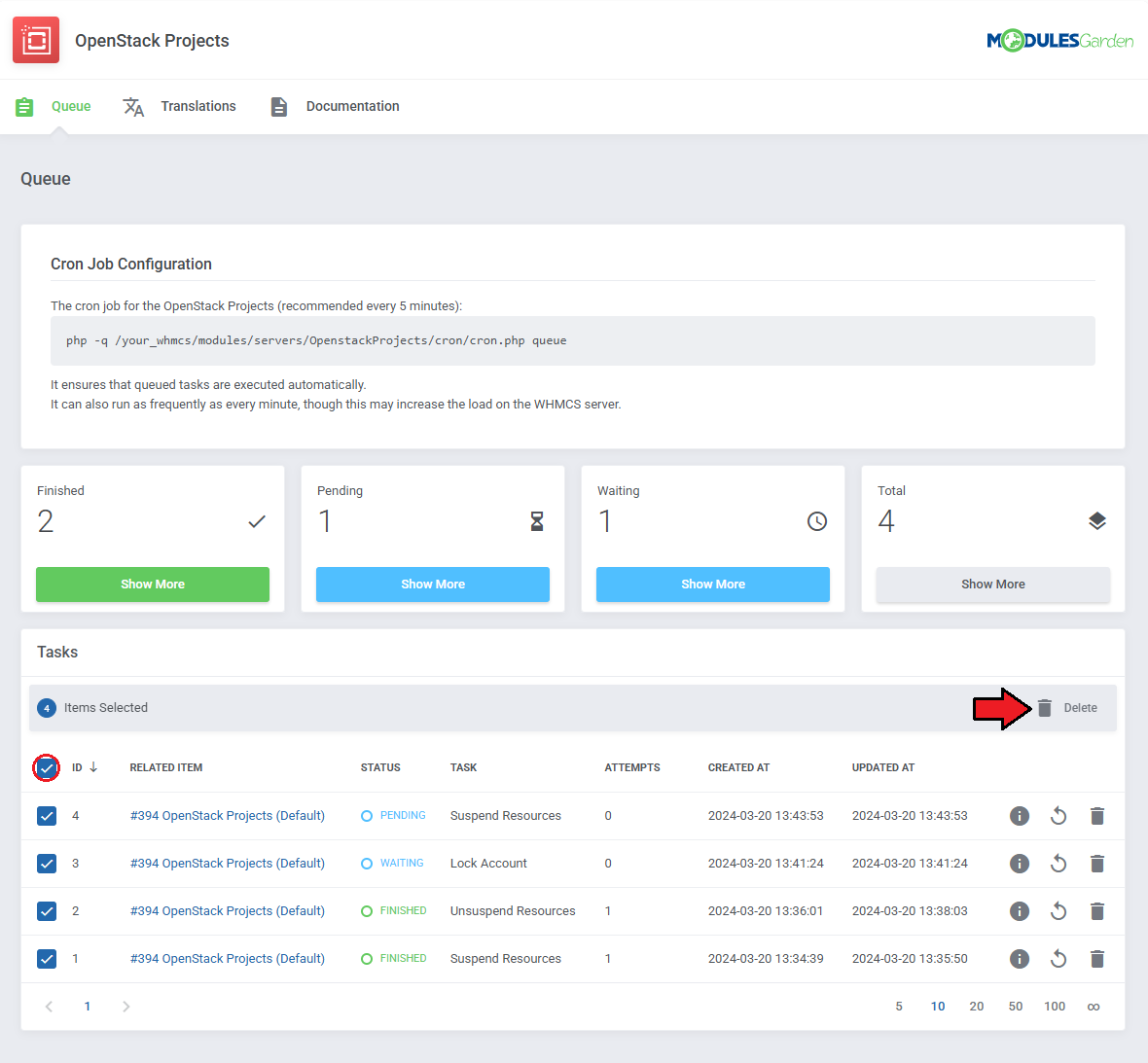
|
Translations
| Customizing language files is now extremely easy with the "Translations" tool that is now available directly in the addon. Its user-friendly design makes managing various language file tweaks a smooth and efficient process. Prepare translations for the original English files with this handy built-in tool. For specific instructions on how to use this tool please refer to its dedicated article, you will find it here. |
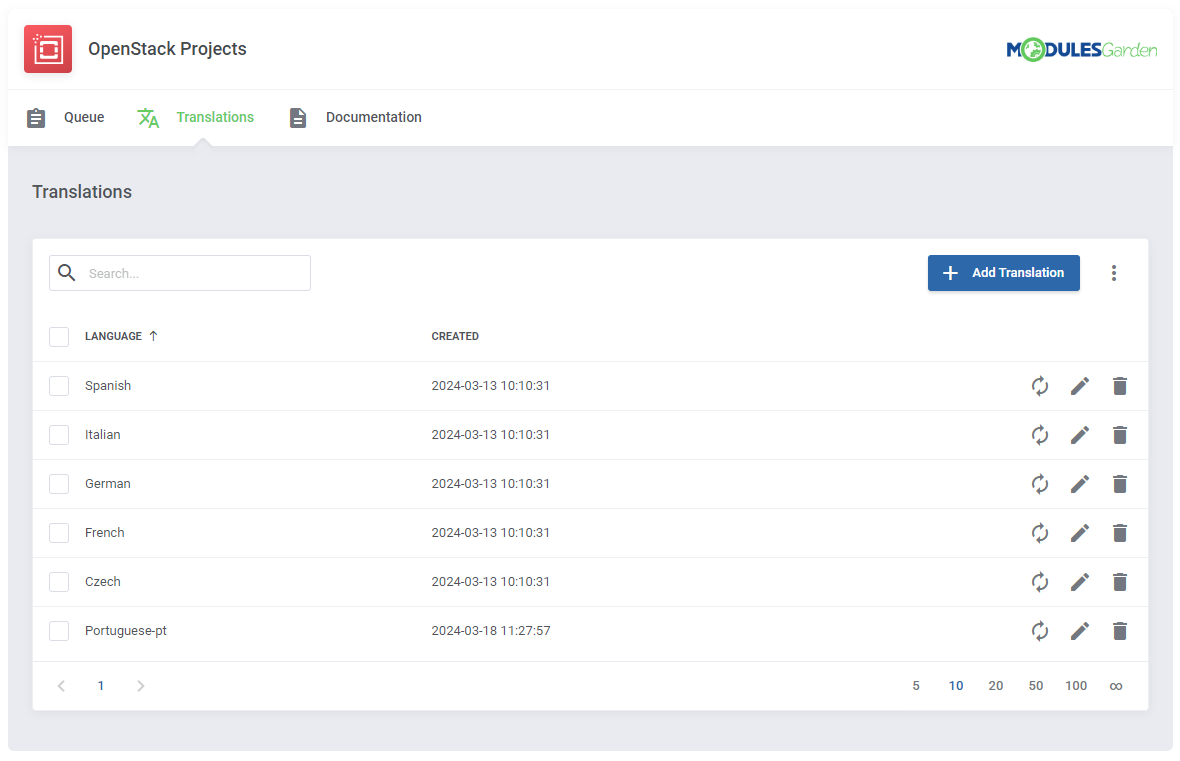
|
Admin Area
| OpenStack Projects For WHMCS allows you to supervise and manage your customer products from the admin area of your WHMCS system. This includes supervision of such features as:
|
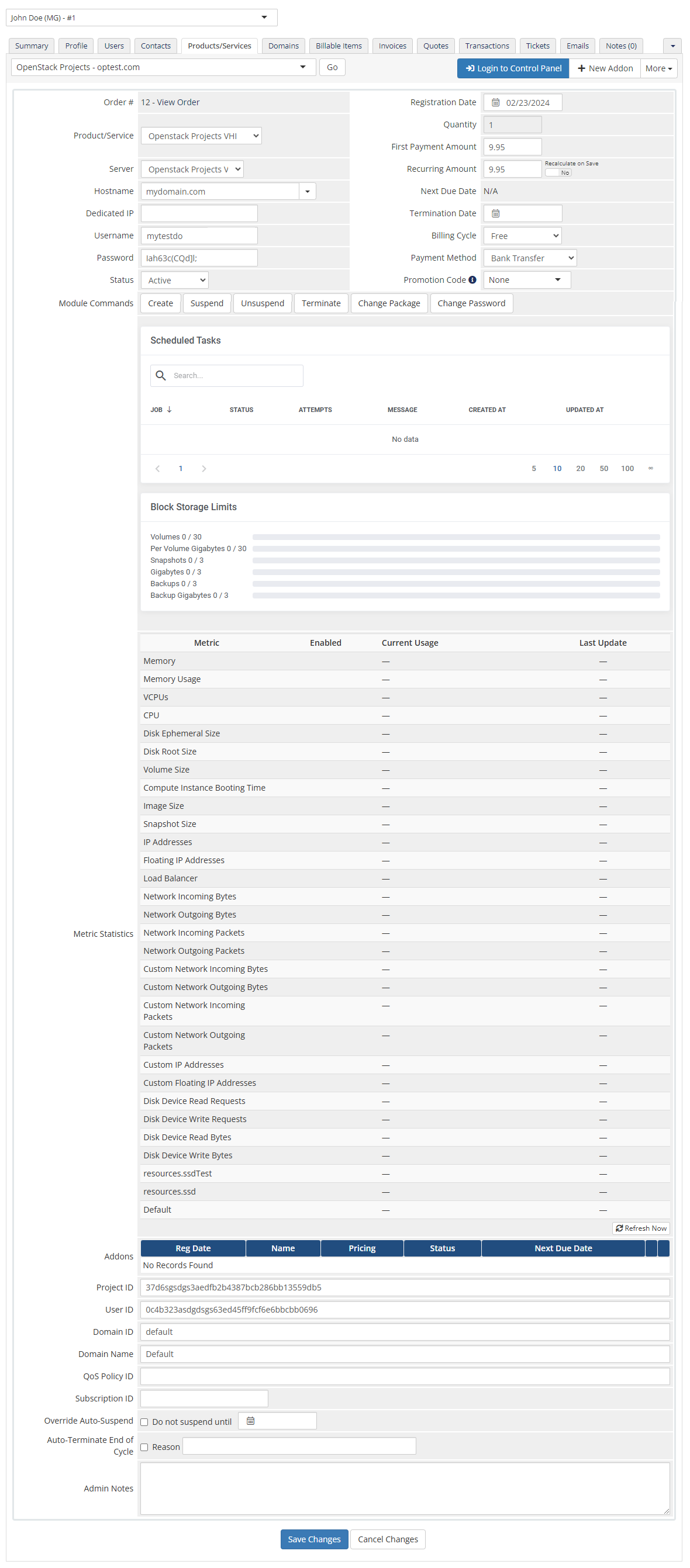
|
Ordering New Projects
| Thanks to configurable options, you are able to offer a product that your clients can match to their needs. Additionally, you are able to set up pricing for each configurable option, which makes your offer even more competitive. |
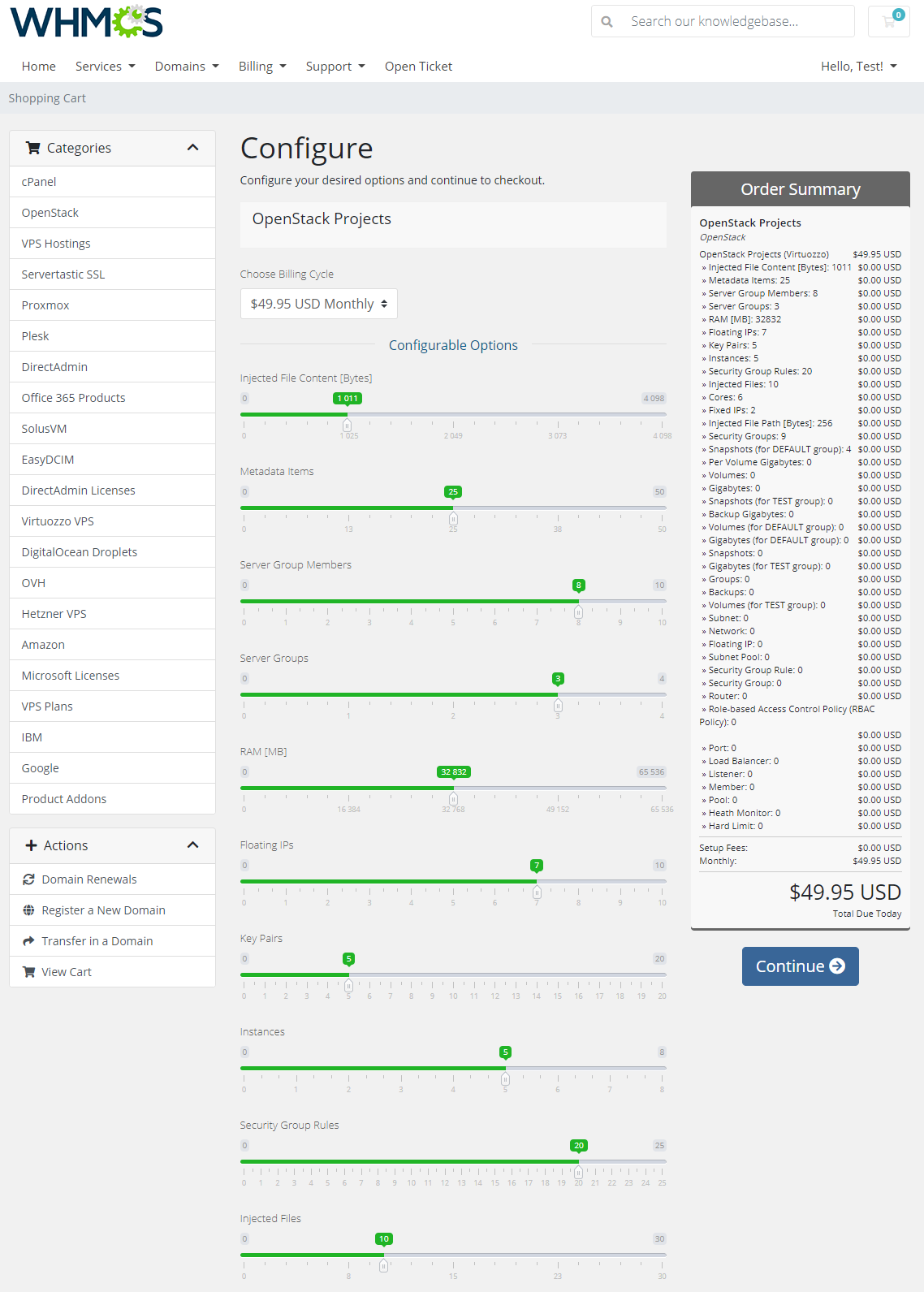
|
Importing Existing Project
| You can easily import existing projects into the module by following the instructions provided below: 1. Find a client to whom you want to assign a project. |
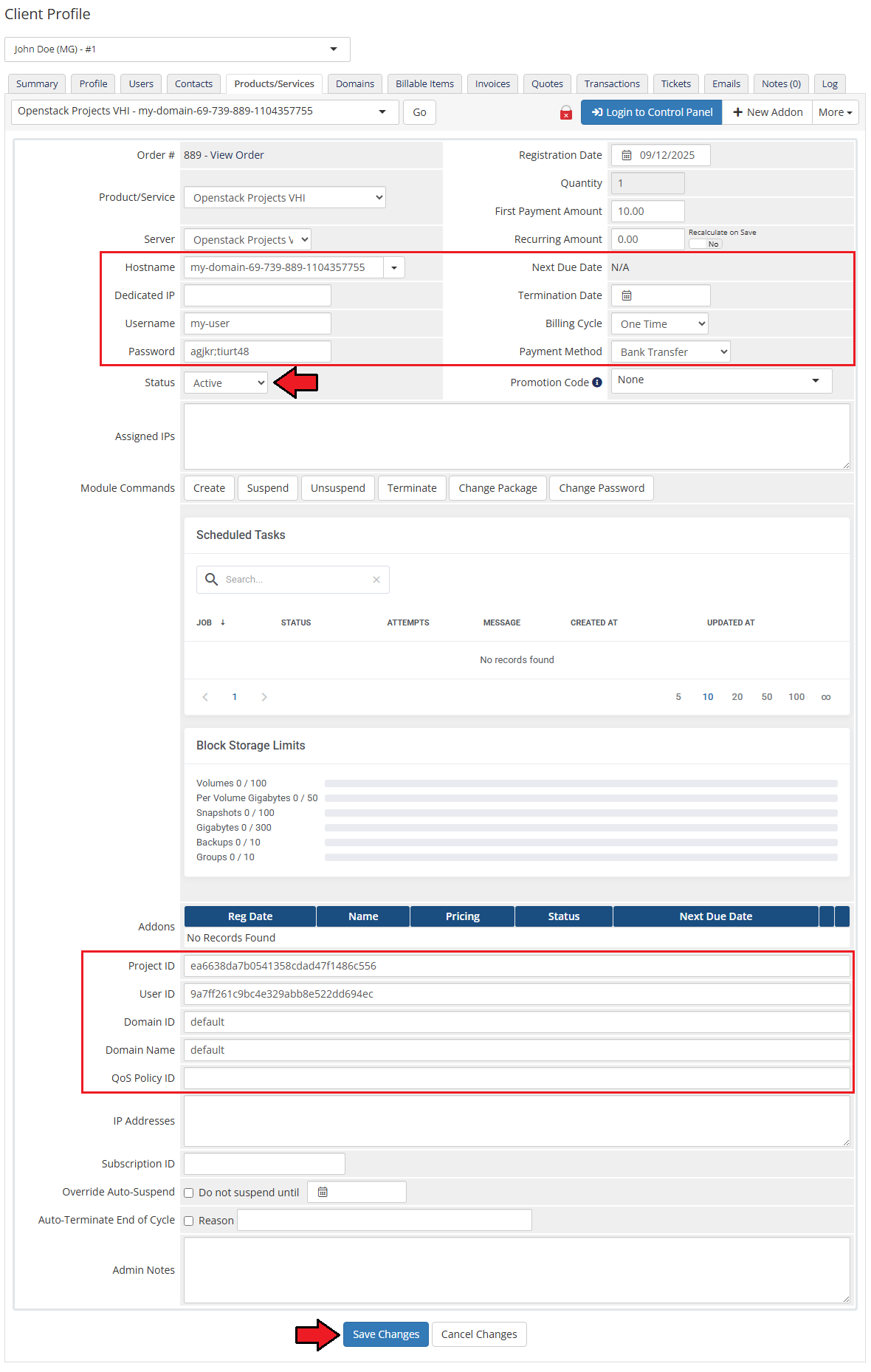
|
Client Area
| The client area interface of OpenStack Projects For WHMCS looks like this. As you can see, you may easily be redirected to the 'OpenStack' login page. Moreover, you can check the 'Configurable Options ' and 'Metrics Billing'. |
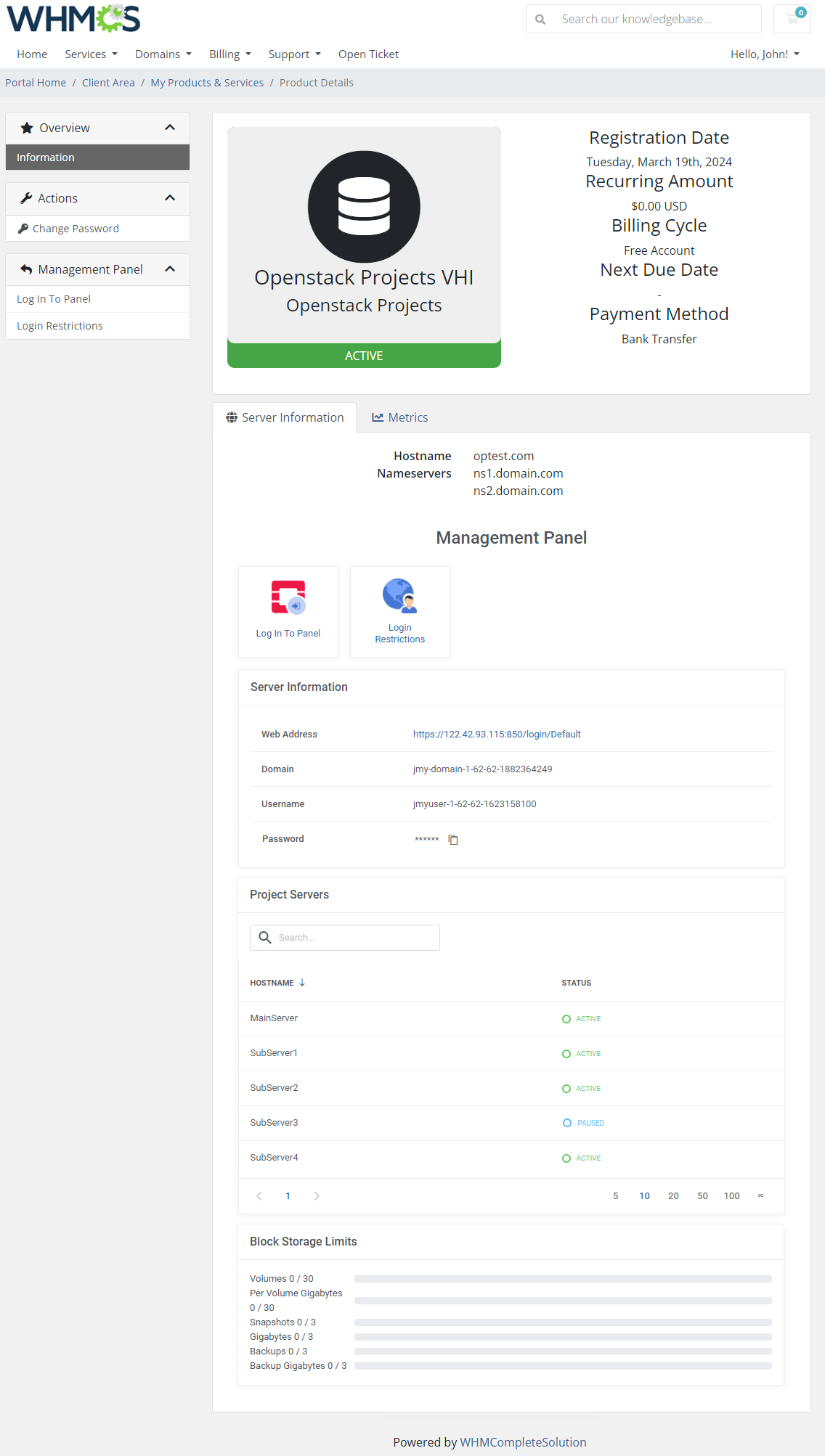
|
If the 'Login Restrictions feature is enabled for your product, you will also find an additional quick access shortcut.
|
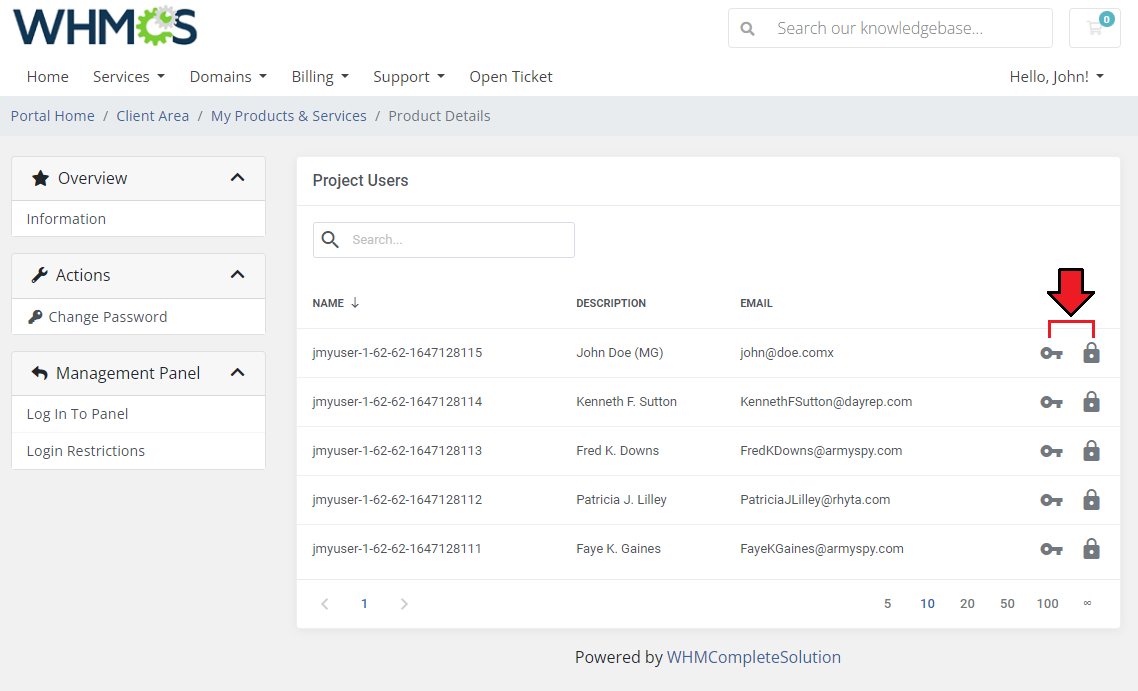
|
OpenID Configuration (VHI)
Customer Domain
| Follow the below instruction step by step to allow adding OpenID configuration automatically: 1. Configure OpenID in WHMCS, read the following article to learn how to proceed. ### VHI ACCESS DETAILS export VINFRA_PORTAL= export VINFRA_USERNAME= export VINFRA_PASSWORD="" export VINFRA_PROJECT="" ### WHMCS OPENID CONFIGURATION ISSUER="" CLIENT_ID="" CLIENT_SECRET="" 3. Move to the product 'Module settings' → 'Module Custom Shell Hooks' section. There add content to the 'Create' and ' Terminate' actions, for example: /home/yourWHMCS/vhi-integration/vinfra-cmd -d {$customfields.DomainName} -a create -n {$customfields.DomainName}
Terminate: /home/yourWHMCS/vhi-integration/vinfra-cmd -d {$customfields.DomainName} -a delete -n {$customfields.DomainName}
|
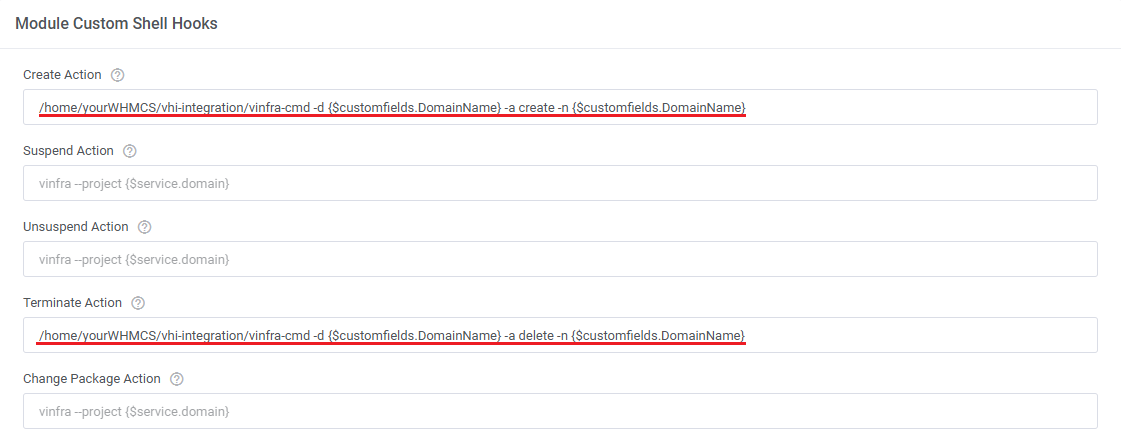
|
| 4. Again, in the 'Module Settings → 'Configuration' → 'Default Domain' select the Create New One option. |
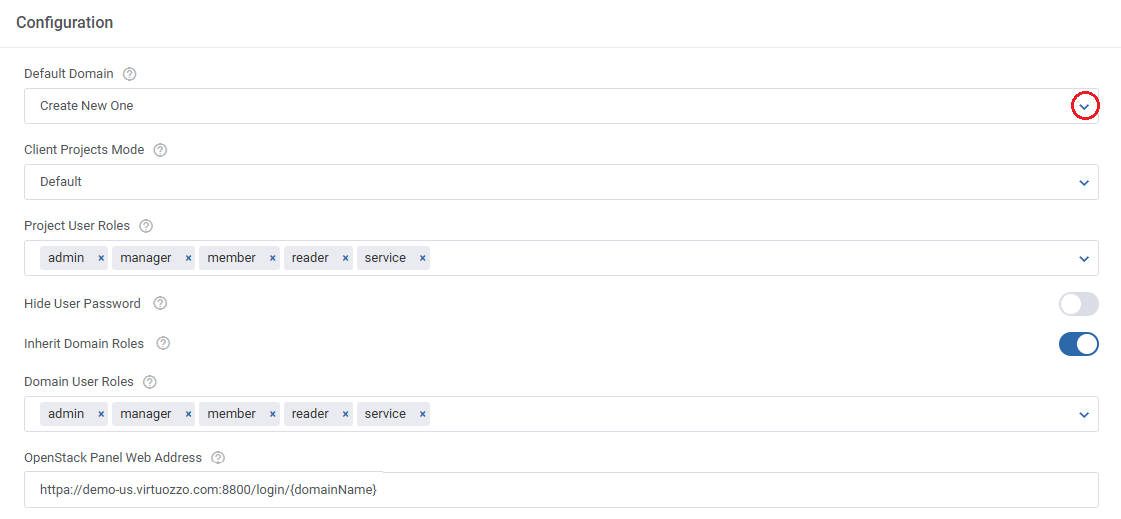
|
|
5. Run 'Create' module command. Important: You must have the vinfra program installed in /usr/bin catalog. Please contact the Virtuozzo team to get it. |
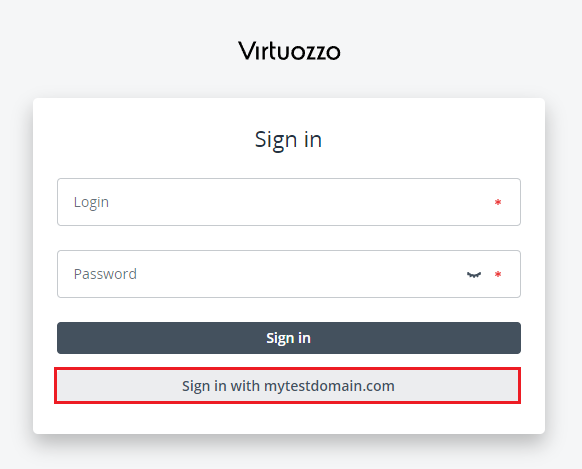
|
| Additional steps required:
1. OpenID Connect → Authorized Redirect URIs. Type in the VHI address that connects to your WHMCS, use the formula: https://VHI_DOMAIN:8800 and/or https://VHI_DOMAIN:8800/api/v2/login/idp/ |
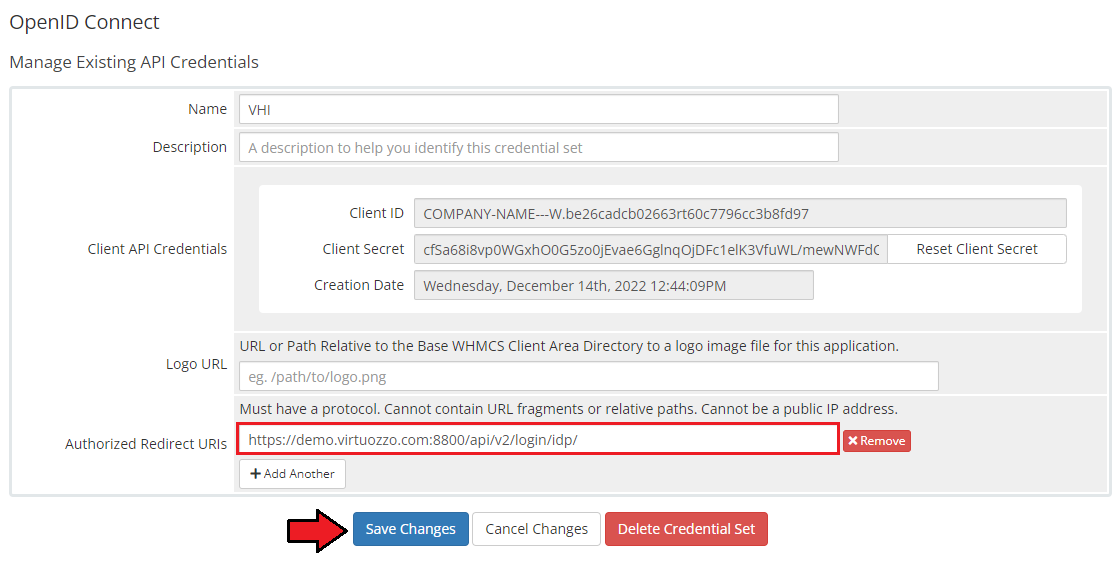
|
2. Add the below lines to the .htaccess file:
Order allow,deny Allow from 138.128.150.246 Allow from 192.168.5.91 satisfy any
RewriteEngine On RewriteRule ^.well-known/openid-configuration ./oauth/openid-configuration.php [L,NC] |
| 3. Domain and WHMCS system URLs must have https protocol: |
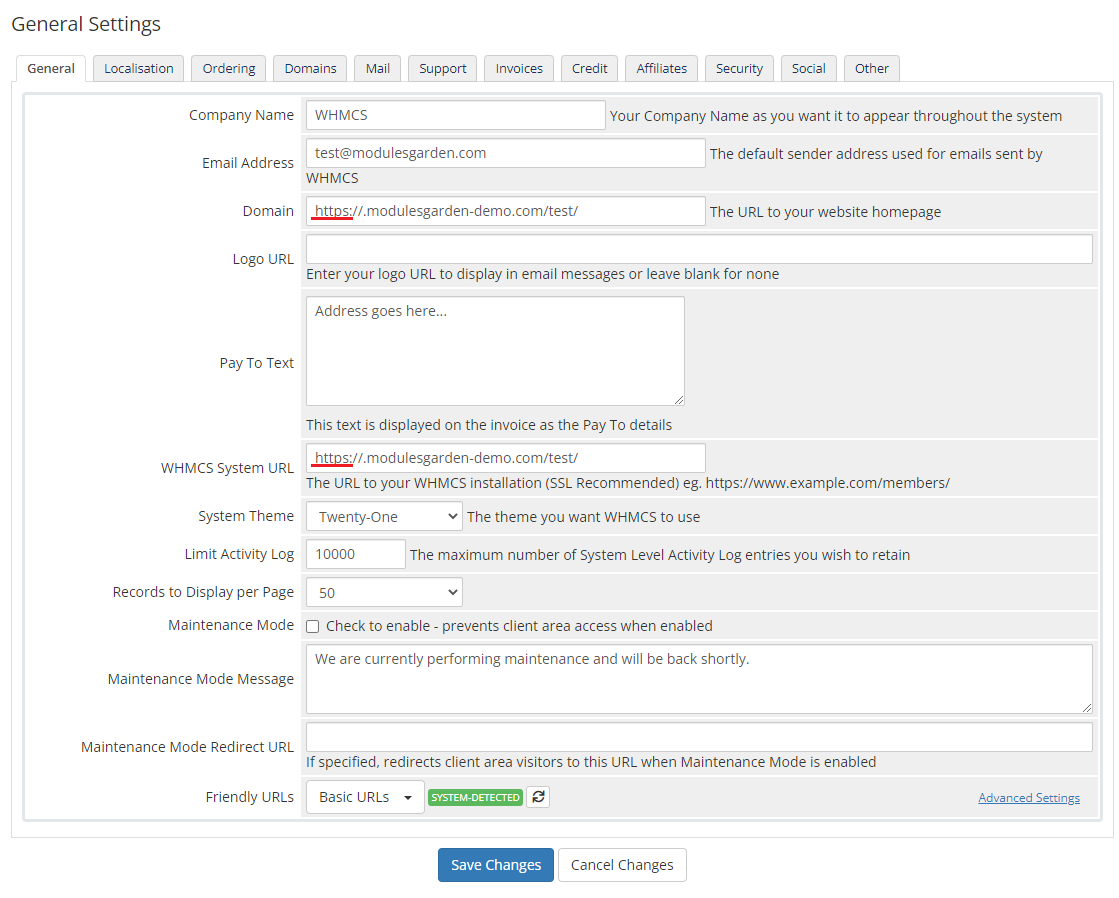
|
| 4. Enter the login link into the OpenStack Panel web address |
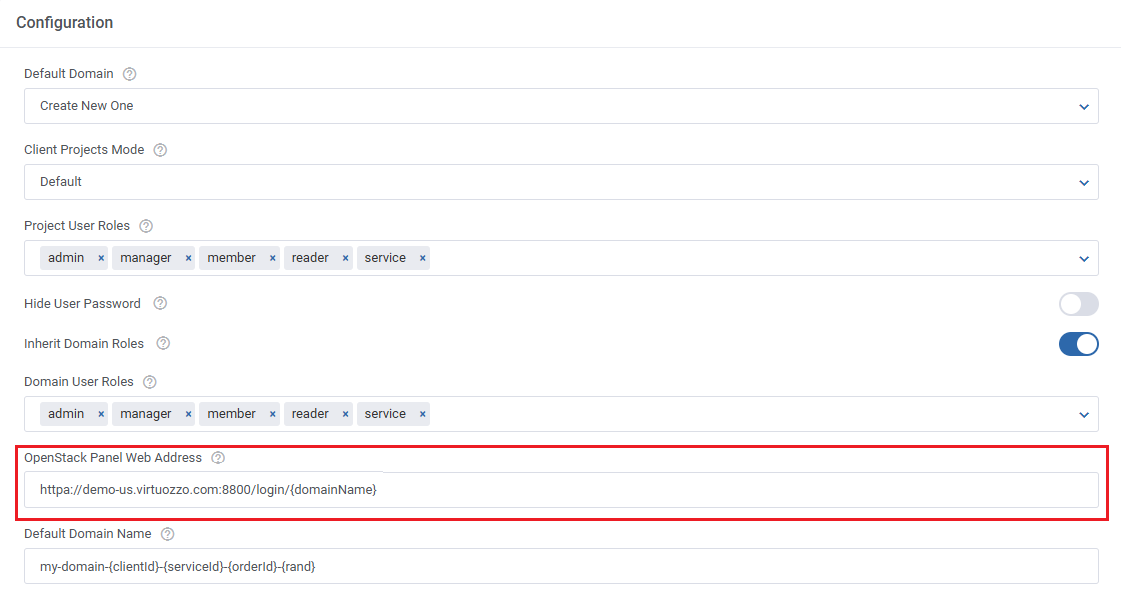
|
Predefined Domain
| Follow the below instruction step by step to use a predefined domain for OpenID configuration: 1. Configure OpenID in WHMCS, read the following article to learn how to proceed. |
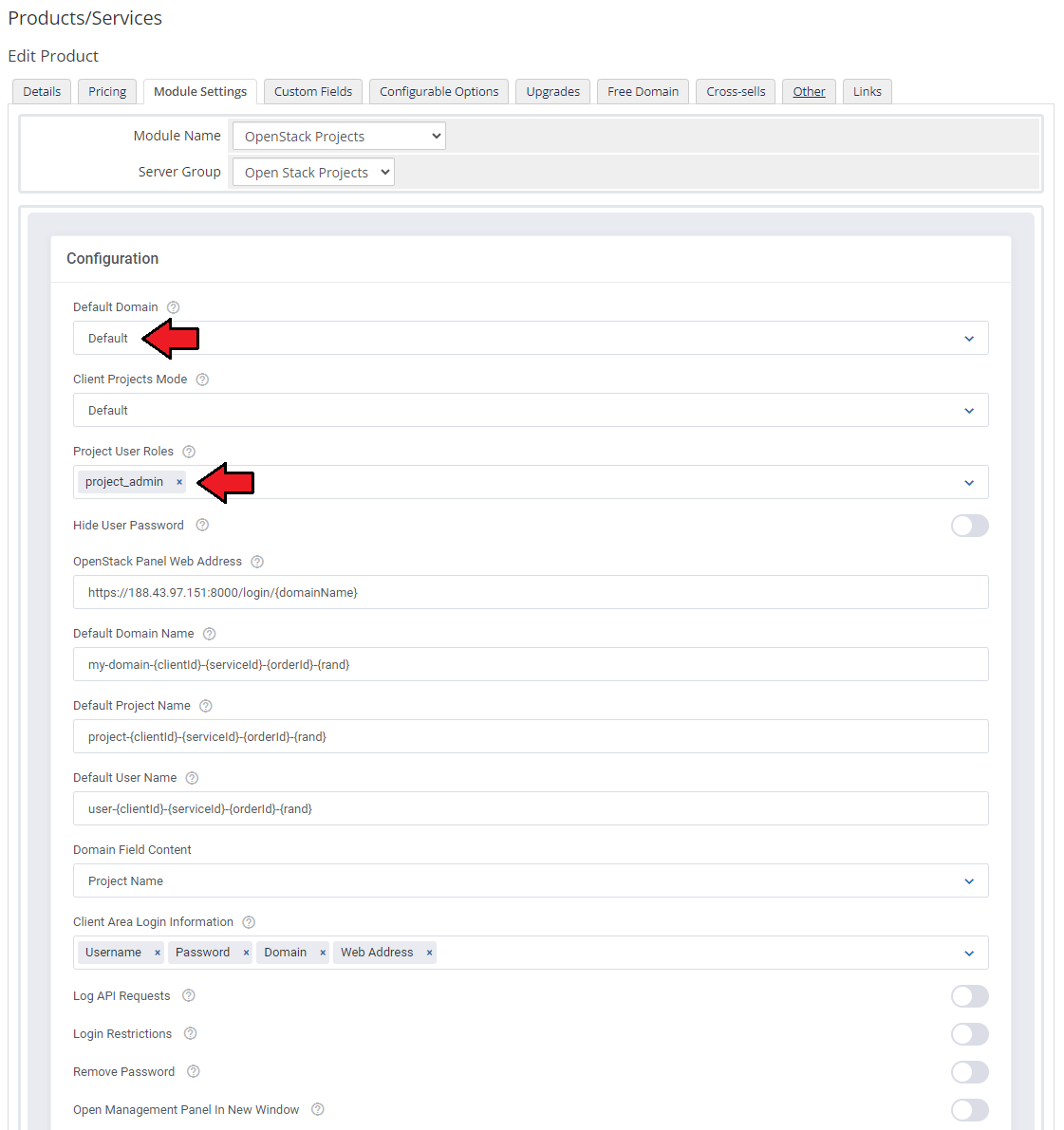
|
| 3. Configure OpenID in VHI. Remember to include the same domain that has been used during product configuration in WHMCS after the '=' symbol in 'Metadata URL'. |
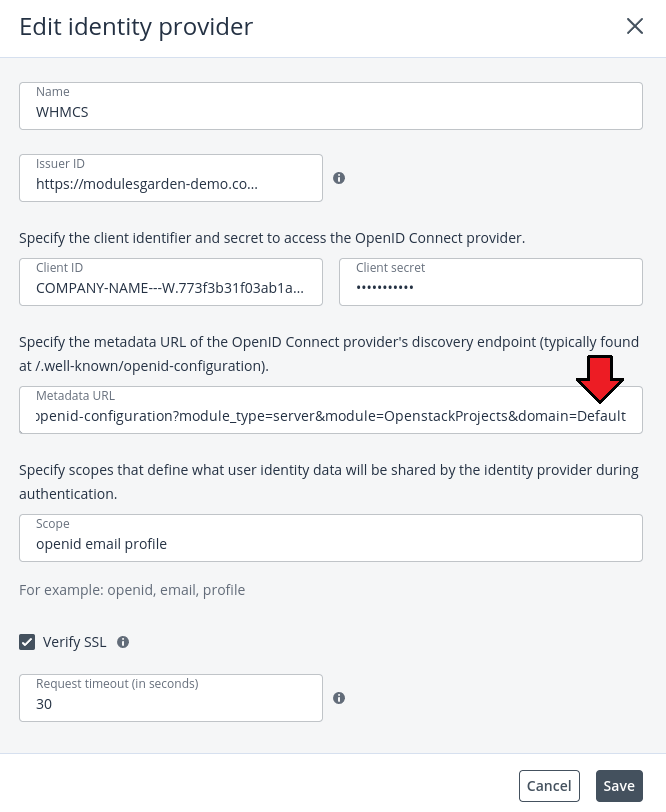
|
| 4. Select 'Authorization Code Flow'. |
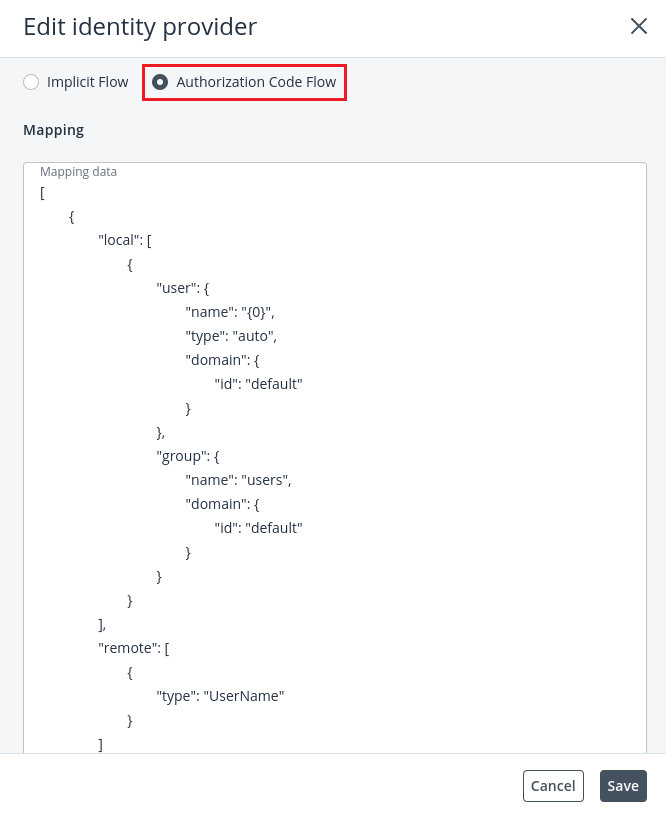
|
Tips
| 1. Please remember that if you integrate OpenStack Projects For WHMCS with Advanced Billing For WHMCS, the cron task should be set no more than once for an hour. |
2. Metrics can be calculated basing on total or average usage for a given period of time. You can edit this in the following file:
/yourWHMCS/modules/servers/OpenstackProjects/app/Config/configuration.yml Find the
|

|
| 3. In the same file, you can disable usage metrics. If you have a large database, this might speed up the module significantly. Set |

|
Update Instructions
| An essential guidance through the process of updating the module is offered here. Before updating your OpenStack Projects For WHMCS module to version 1.8.0, it is strongly recommended to delete all files (excluding license.php) located in: /yourWHMCS/modules/servers/OpenStackProjects/. After a successful upgrade, please proceed to the product's module settings section to ensure a smooth transition. |
Upgrade Guide
| Seeking a solution that offers greater flexibility, customization tailored to your precise needs, and unrestricted availability? There is an option that not only proves to be cost-effective in the long run but also includes prioritized support services, making it a truly valuable investment. Opt for the Open Source version of your OpenStack Projects For WHMCS module to unlock these benefits. Follow a comprehensive guide covering the transition process, the advantages it brings, and step-by-step instructions on what to do next after the order has been successfully finalized. |
Common Problems
| 1. When you have problems with connection, check whether your SELinux or firewall does not block ports. |
| 2. If you encounter a connection error in the module settings: 'Error:Connection Error: No route to host (Action: GET https://compute-api.svc.vstoragedomain.:8784/v2.1/5dcda23cb9bd4718b32610bbe18a1382/os-availability-zone). Check WHMCS module log for more information' |